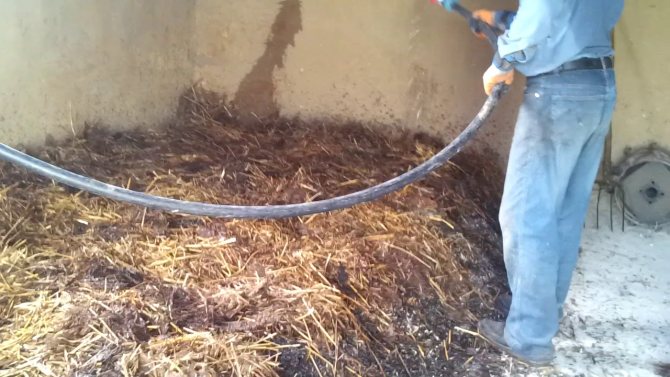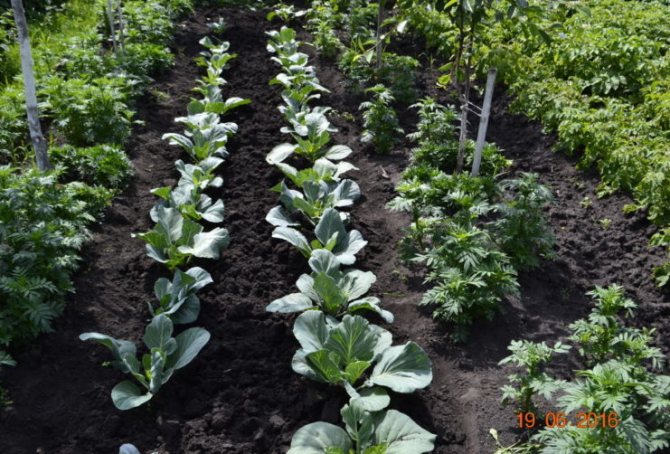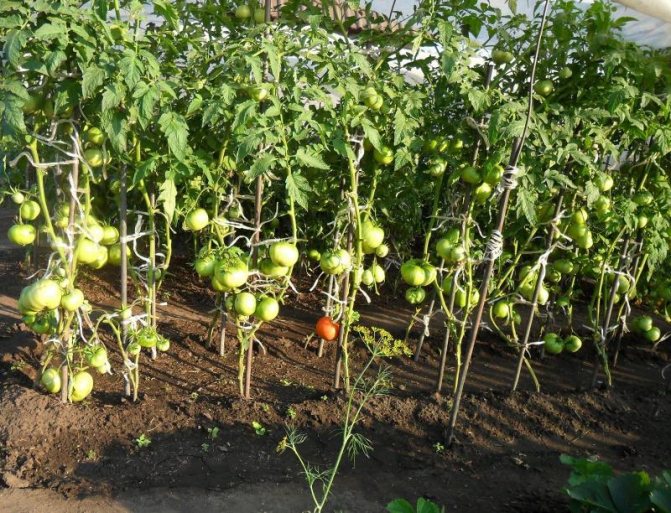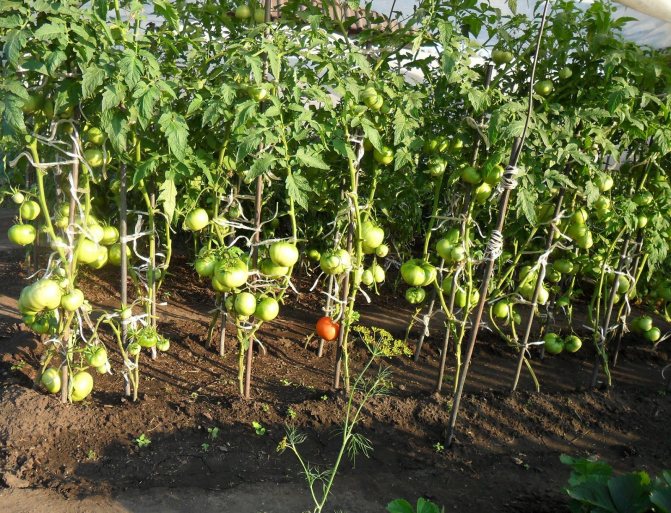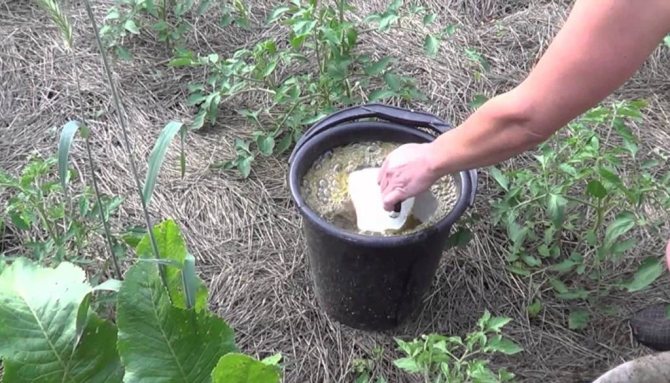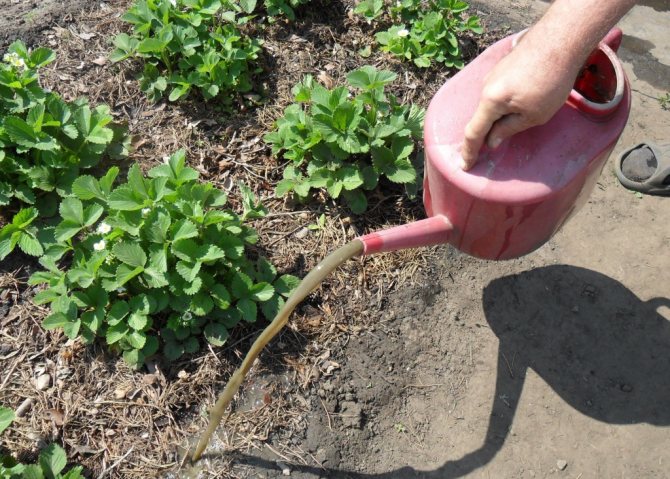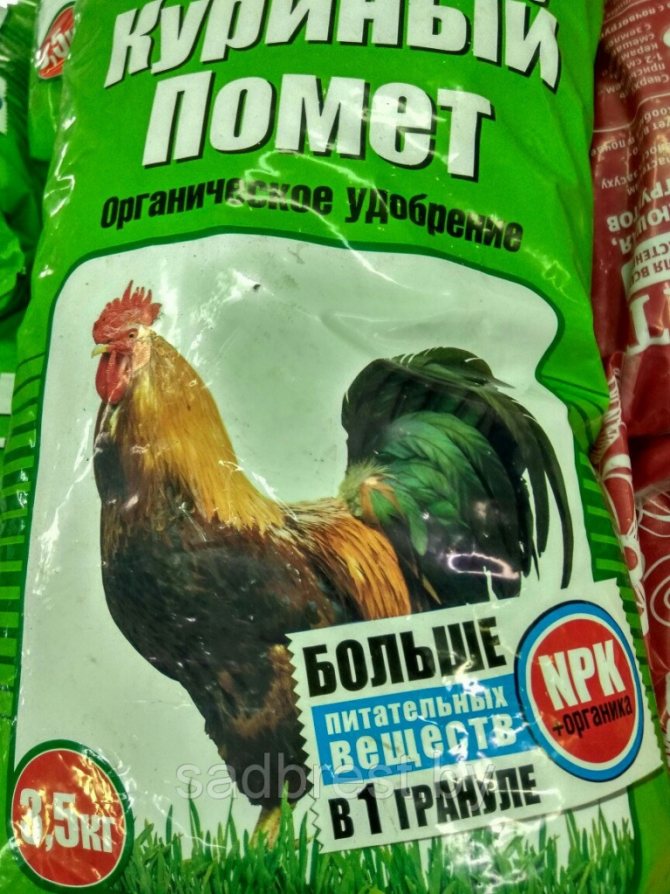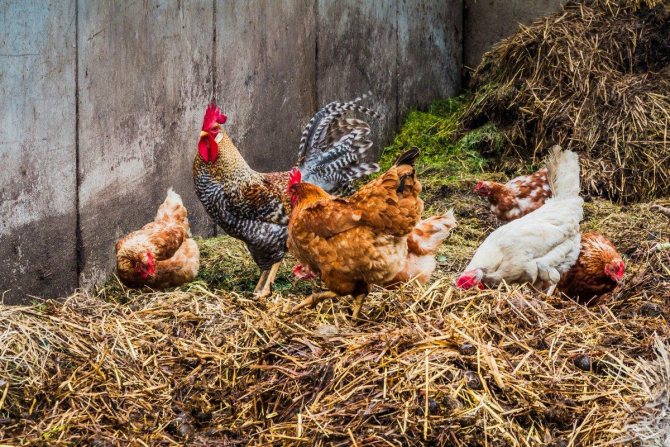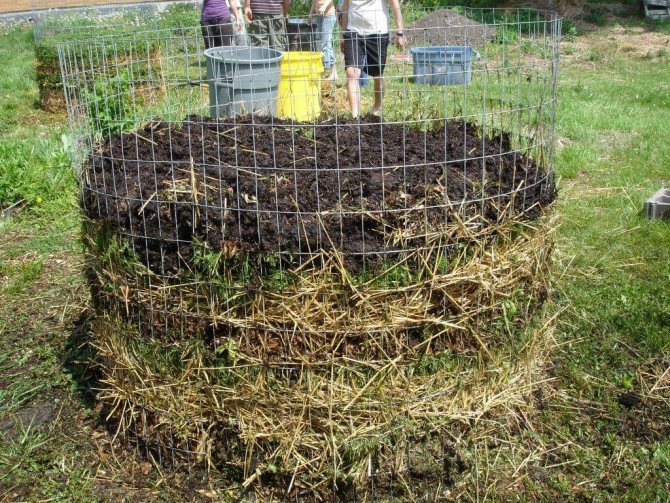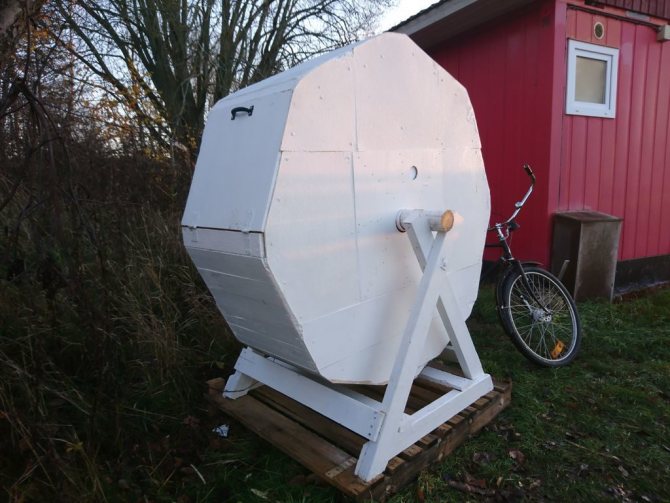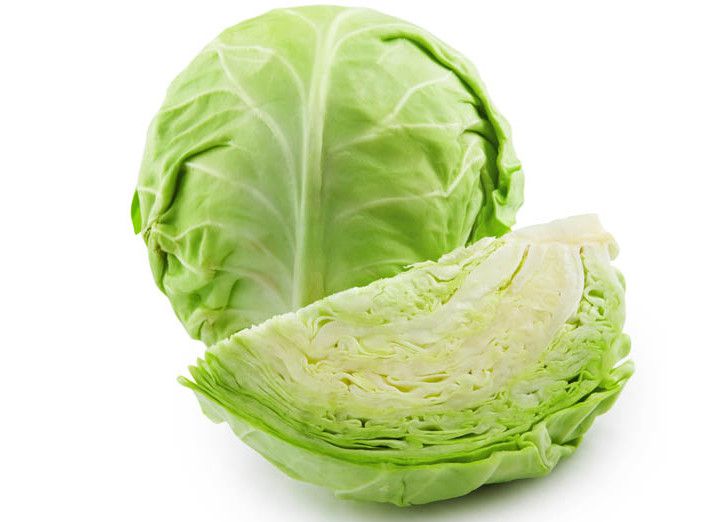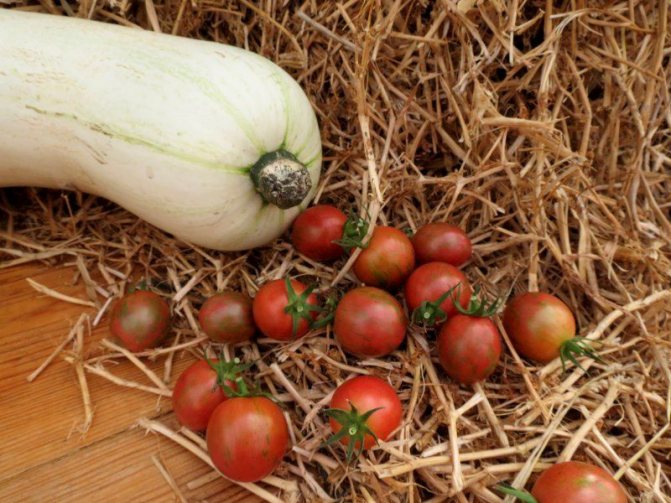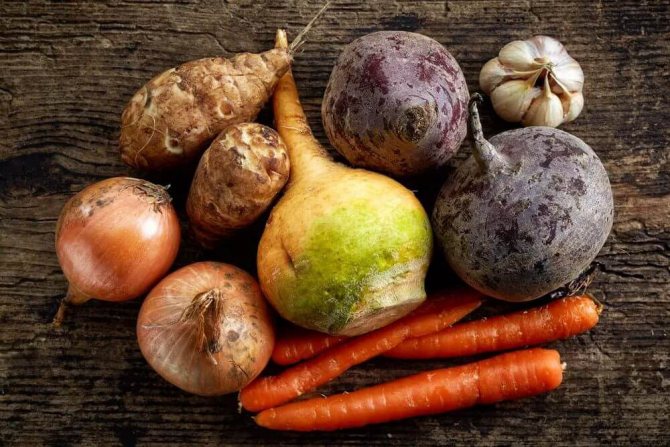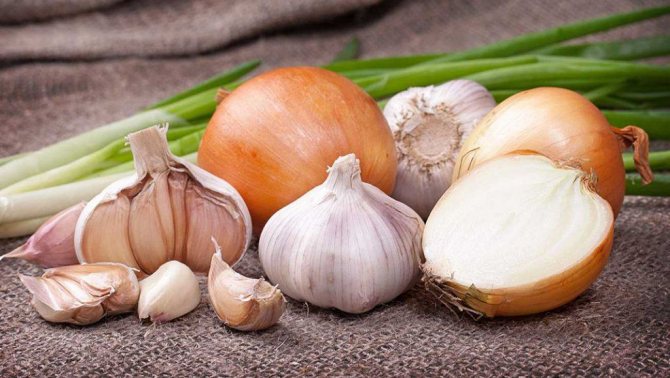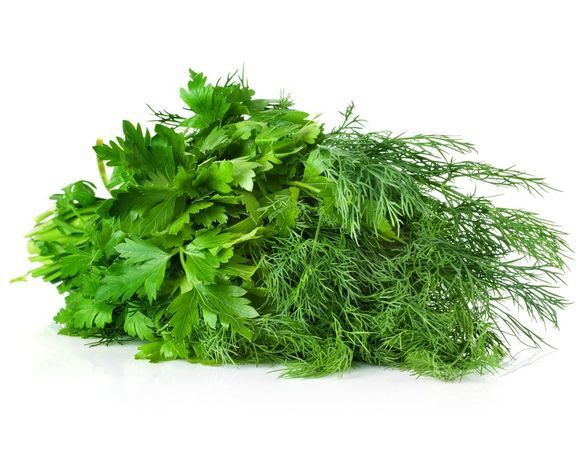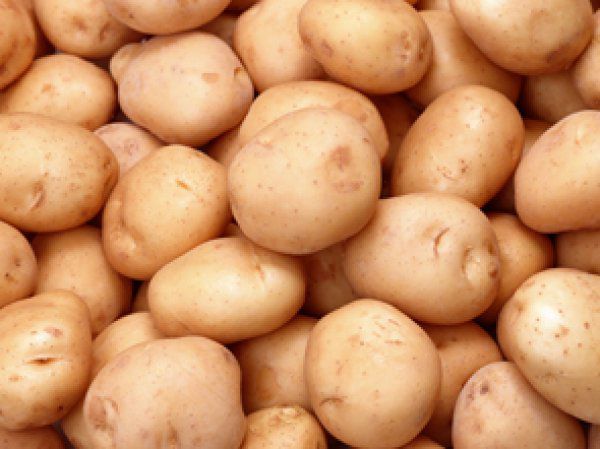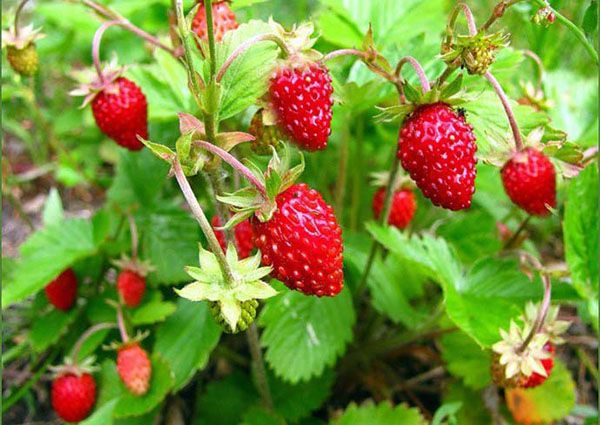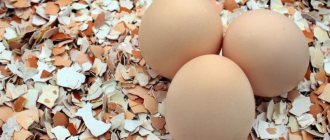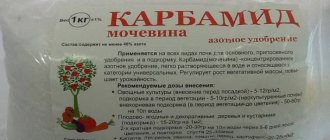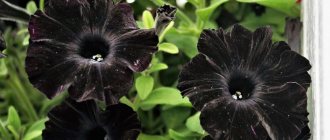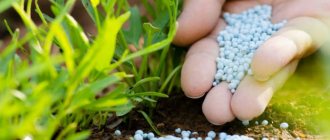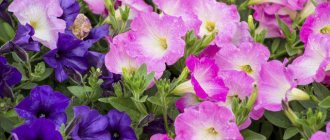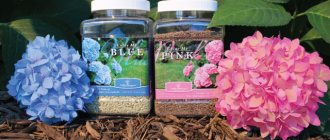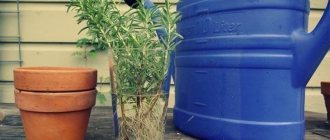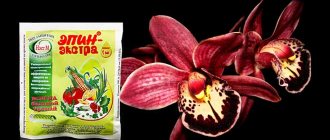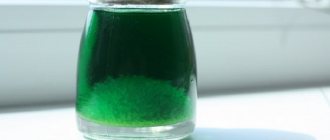Why litter is useful for a plant
The use of poultry droppings, due to the high concentration of necessary elements in it, causes the active development of plants. Moreover, the results can be seen literally a few weeks after feeding. Bird droppings accelerate biological processes in the soil, supply crops with carbon dioxide.
For plants, it is difficult to overestimate the importance of this fertilizer, because it:
- increases the number of ovaries;
- promotes faster ripening of the crop;
- makes the taste of the fruit more intense;
- makes plants more resistant to disease;
- improves water and air permeability of the soil;
- prevents moldiness of the soil.
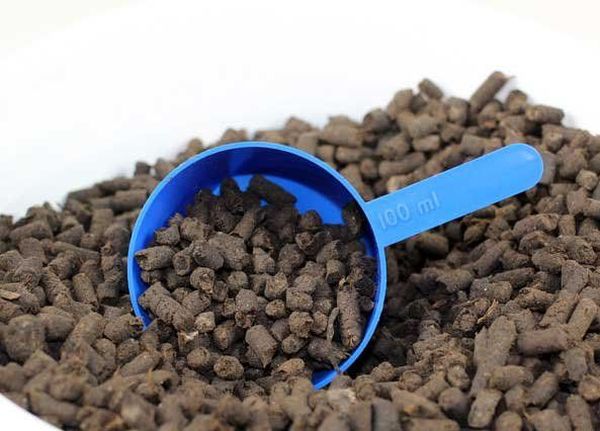
For a very long time, poultry manure has been used in agriculture.
Advantages of chicken manure
The composition of chicken manure is such that the content of useful elements in it is not inferior to most chemical fertilizers. For example, it contains 33 nitrogen and 8 times more phosphorus than horse manure. It was discovered in the 18th century by the German scientist Liebig. Unlike other types of manure, chicken manure:
- accelerates the course of biological processes in the soil layer;
- increases productivity, accelerates ripening;
- inhibits soil mold;
- contains nitrogen in a form suitable for assimilation by plants;
- the beneficial effect persists for another three years after application;
- plant roots are able to extract up to three quarters of nitrogen in the droppings;
- lasts longer in the soil word than artificial analogs.


The chemical composition of chicken manure
The content of nutrients in chicken manure is increased so much that a small amount is required for feeding. It is very caustic and oversaturated with nitrogen, therefore it is not used in fresh undiluted form.
Biological action: substances contained in chicken droppings accelerate photosynthesis and supply plants with nutrients. In practice, this leads to an acceleration of growth, an increase in the volume of tops, leaves and fruits. However, it increases the formation and growth of tubers insignificantly.
Fertilizer properties and benefits
Among organic fertilizers, poultry manure occupies a special place due to its outstanding properties and advantages:
- environmental friendliness - does not contain harmful substances, if the standards of use are observed, it improves the composition and properties of the soil;
- availability - many farms keep poultry, and the amount of droppings often exceeds their own needs;
- saturation with useful substances allows you to economically apply this fertilizer;
- lack of toxicity and the ability to spontaneously ignite.
How to use manure as fertilizer for different flowers
Each plant reacts differently to feeding. Experienced gardeners find an individual approach to each flower culture. Not every plant will enjoy applying manure.
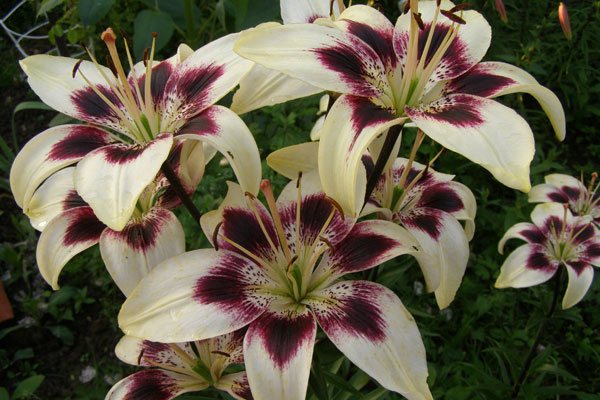

Lily "purple rain" Asian hybrid
For asters and nasturtiums, watering with a mullein is not recommended, and bulbous plants (tulips, daffodils) will develop better after introducing organic matter based on animal excrement.
- Lilies need to be fertilized with diluted mullein infusion when the first true leaves appear. You will get a healthy plant with large, bright flowers.
- In spring, peonies should be mulched with humus, compost with a layer of 10 cm. When the first leaves appear, spray the flowers with urea diluted with water.
- For clematis in the spring, pour organic fertilizers with a teaspoon of organic fertilizers into the hole. Excess organic matter can harm the plant.
- Astilba needs to be fed with a mullein during the growing season.
- The host needs to be watered with mullein solution. The proportions are 1:10. Top dressing should be done in spring and June. It is impossible to apply fertilizers later, as the flower can grow loose leaves, which attracts harmful insects.
- For phlox, feeding is often needed. In the spring, cover the ground with compost or humus. At the end of spring, fertilize with infusion of mullein with wood ash. Dry top dressing should be done before rain, liquid dressing after watering.
Perennial flowers are fed three times a year. In the spring, you need to add humus or compost from manure and loosen the soil well. The next step is feeding when the first leaves appear or during the flowering period. In order for flower crops to stock up on nutrients for the winter, organic matter needs to be added after flowering. For the successful development of annual flowers, two dressings are enough - after planting in the ground and during the formation of buds.
What can be fed chicken droppings
The unique properties of chicken manure make it possible to use it as a fertilizer for most crops - garden trees and shrubs, garden and ornamental plants. In this case, it is necessary to adhere to the norms and terms of fertilization, taking into account the type of plant, the stage of its development and the composition of the soil.
Tomatoes, cucumbers and peppers
Poultry manure as a fertilizer for tomatoes, cucumbers and peppers is used by most gardeners. At the same time, it is important not to overfeed the plants - a small excess of nitrogen leads to an active growth of green mass and a decrease in the number of fruits, and a significant one can destroy plantings.
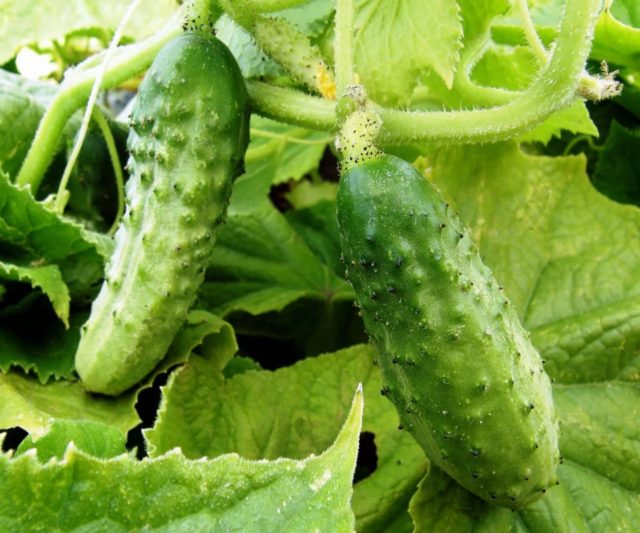

Most gardeners use poultry manure as fertilizer
If the beds or greenhouse soil have been fertilized in the fall, then additional fertilizing with droppings is not required. For unprepared soil, one or two applications of manure solution under the root or between rows are sufficient.
Strawberries
Strawberries, or rather garden strawberries, are fertilized with dry bird droppings, adding it to the hole when planting. You can also feed the bushes with a solution in the spring before flowering, but no more than twice. They introduce top dressing into the aisles after watering or rain, not forgetting that an excess of top dressing will lead to the accumulation of nitrates in the berries.
Compost, completely rotted manure can be effectively used as strawberry mulch. At the same time, the need for liquid feeding with any nitrogen fertilizers disappears.
Flowers
Bird droppings are also suitable for feeding annual and perennial ornamental plants. In this case, the use of droppings is carried out according to the rules for the use of any nitrogen fertilizers. Top dressing is applied at the beginning of the growing season. The dosage depends on the plant species and soil composition.
Bird droppings are also effective for indoor flowers. But it is better to use granulated chicken manure in order to prevent a specific aroma in the room. In the form of compost, bird droppings can be included in the soil of indoor plants - it will improve the composition of the soil and will not create discomfort in the house.
Potatoes
Potatoes, like any other plant, need nitrogen, but the need for it is small. Excess nitrogen stimulates active growth of tops to the detriment of tuber formation. For potatoes, the most effective is the use of compost from poultry manure, which is applied for plowing in autumn or early spring. Consumption rate - 50 kg per 100 m2.
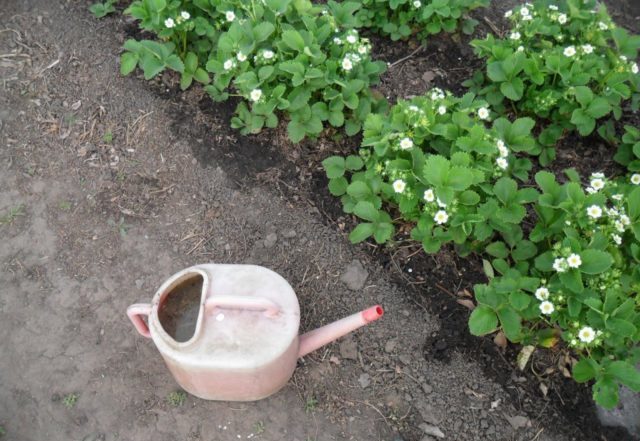

Strawberries are fertilized with dry bird droppings
Grapes
Bird droppings, especially chicken and pigeon droppings, are one of the best fertilizers for grapes.Top dressing is done twice - in spring before flowering and in summer, after the formation of bunches, when the size of the grapes reaches 5-7 mm.
For root feeding, a solution of fermented droppings is introduced into grooves or holes dug out at a short distance from the bush. The concentration of the solution for grapes should be less than for vegetables. The solution consumption depends on the age of the grapes. Up to 3 years, one bucket per bush is enough. Further, the amount of fertilizer is calculated as 10 liters per 1 m2 of the root system area.
Roses
Rose bushes are not too demanding on the amount of fertilizer plants. Moreover, an excess of nutrients in the soil can harm the bushes. Bird droppings are used to fertilize roses in the presence of signs of nitrogen deficiency - weak growth, lightening and yellowing of leaves, thinning of shoots. The liquid solution is applied once a year in the spring until the buds appear at a rate of 10 liters per m2. Dry bird droppings can only be used as compost. You can not feed bushes under three years old and plants weakened by diseases with droppings.
Fertilizers from chicken manure
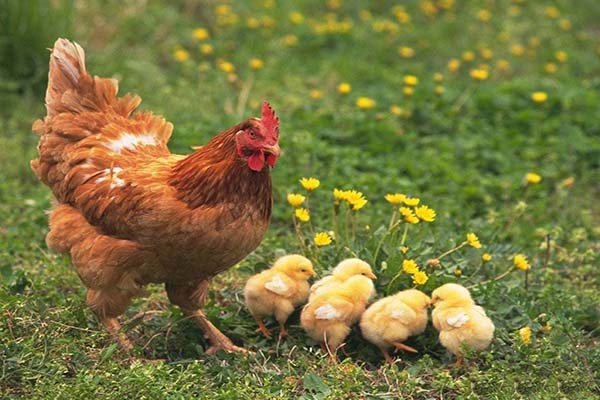

Chicken manure is rich in nutrients: nitrogen, phosphorus, potassium, magnesium
A gorgeous flowering flower bed will appear on your site if you use chicken manure for organic application. Flowers will thank the gardener with bright numerous flowers, you just need to properly feed. Chicken manure is characterized by a variety of nutrients: nitrogen, phosphoric acid, potassium, magnesium, sulfur. Such fertilization is especially rich in phosphorus and nitrogen. The content of these elements in the composition of chicken manure is several times higher than the number of elements found in cattle manure. To improve the development of plants, gardeners mix one part of chicken manure with three parts of sawdust and straw, and then spread it on the ground next to flower crops.
Methods for preparing liquid fertilizers from chicken manure
- Fermentation method. Agrotechnical stores now have the necessary preparations to speed up fermentation. Previously, this method was used exclusively on poultry farms. The sawdust must be treated with a special preparation and poured into the chicken cage. When cleaning the cage, sawdust with droppings must be mixed and placed in a certain place. When the heap is the right size, it needs to be watered with a fermentation accelerator. After a month, the pile needs to be dried, and the flower food is considered ready.
- A simpler method is to infuse chicken manure. To prepare it, you need waste and water in a ratio of 1: 100. The color of the finished solution resembles brewed tea. If the shade is brighter it is recommended to dilute the preparation.
- To get rid of urea acid, chicken manure is soaked for 2 days. Then the water is poured out, fresh is added. This procedure is carried out up to four times. The resulting content can be added to the soil when planting.
Granular fertilizer from chicken manure
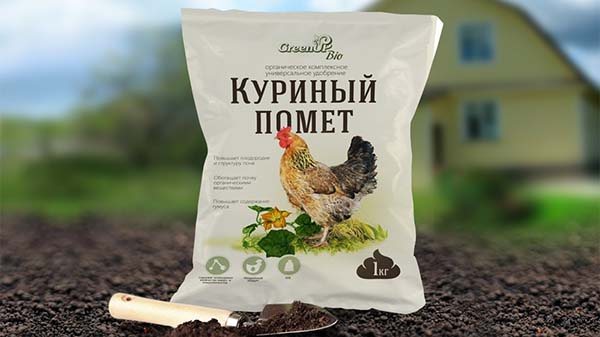

A great alternative for indoor flowers
In modern stores, you can buy organic preparations in liquid and dry form. Dry chicken manure is sold in the form of granular formulations.
- To prepare a liquid solution from granules, it is required to insist 400 grams of the drug with one bucket of water for a day. An excellent nutritional supplement for flowers will be if you just bury the granules in the soil. When the components are decomposed, the roots of plants will receive all the necessary nutrients. When flowering, plants are fertilized with a solution of 100 grams. granules and 10 liters of water.
The use of chicken manure has a beneficial effect on the intensive growth of flower crops, the formation of flowers. For home indoor flowers, it is better to use a dry mixture to avoid unpleasant odors and root burns. The drug is mixed with the soil mixture or deepened into the soil near an already grown plant.
For which plants and vegetables is bird droppings contraindicated?
The saturation of poultry droppings with nitrogen makes it unsuitable for feeding plants sensitive to high concentrations of compounds of this element.
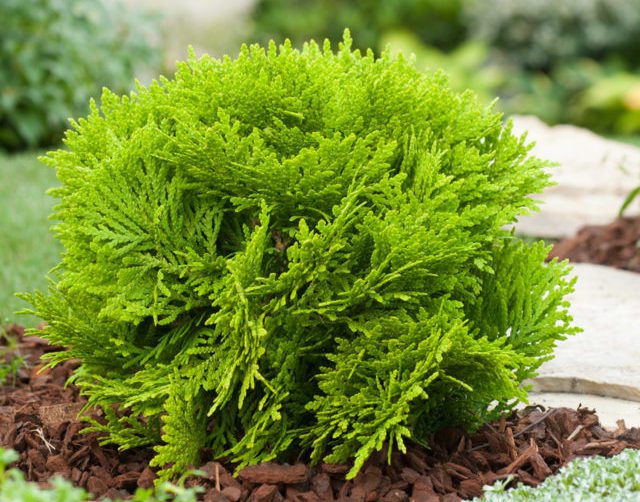

For fertilizing thuja, bird droppings are contraindicated
These include, first of all, plants of the coniferous and heather families:
- blueberries;
- blueberry;
- heather;
- thuja;
- spruce;
- Pine;
- fir;
- juniper, etc.
Also, you do not need to fertilize rhododendrons and camellias with bird manure.
It must be borne in mind that fresh bird droppings can be dangerous to any plants, as it can burn the roots and stems.
Using dry bird droppings
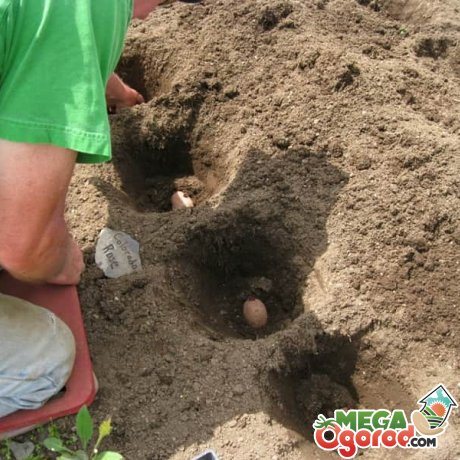

Poultry droppings are introduced into the soil in late autumn or spring at 500 g per m2, leveled evenly over the site so that there are no large lumps left. Digging up the soil. For growing seedlings, 40 g of droppings are added to the holes. To feed strawberries and other berries, 300 g of dry droppings are added per 1 m2.
Fresh bird droppings are sometimes added to fertilize shrubs and trees.
No more than a bucket of chicken manure is brought under one tree per year. Under the bush - 2 or one and a half times less, depending on the height of the bush. When spreading in this way, it should not be poured close to the trunk. They dig up the soil and water it. When planting young trees, 1 kg of poultry manure is introduced into the planting pit, mixing with soil and other mineral fertilizers. Do not allow droppings to get on tree roots. Young trees do not require feeding for three years. After all, the action of the litter is designed for such a time.
Bringing in fresh chicken droppings is dangerous for plants. If there is too much of it, young plants will stagnate and may die. It is better to prepare compost from it, which can be made in several ways:
- The droppings taken out of the hen house are piled up. You can add cow dung to it. It should be borne in mind that it is 3 times weaker than chicken. But this is not scary, the main thing in using such a fertilizer is not to exceed the concentration and not to pour too much. Periodically shed with water and shoveled at least twice in the summer. After 2 months, the compost is ready.
- You can prepare high-quality compost with mineral fertilizers. To do this, they need to pour over layers of manure.
- If there is peat, you can compost this way. Pour a layer of peat mixed with straw, sawdust. Sprinkle on top with a layer of chicken manure 20 cm thick. Repeat the procedure several times. Spill with water, shovel. If you add M-bokashi to the compost, the composting process will be much faster.
Handle chicken droppings with care. It may contain helminth eggs. Therefore, hands should be washed after handling the substance. If the litter is too dry, then during the work with it, the smallest particles penetrate into the respiratory tract. In order to avoid this, put on a gauze bandage or pre-spill it with water. Children are not allowed to work with chicken droppings. After preparing the fertilizer or using it, wash your hands thoroughly with soap and water. The container is washed. After that, it is suitable for preparing the next batch of fertilizers.
Optimal timing for application to the soil
Do you use folk signs in gardening?
Any fertilizer is effective if its application corresponds to the life cycle of the plant. Nitrogen affects the growing season; accordingly, it is advisable to use poultry manure as fertilizer in spring and early summer. The use of droppings at the time of fruiting and after its completion is not justified, since it only leads to an increase in green mass, and does not affect the yield. Moreover, pre-winter feeding gives an impetus to the growth of young shoots, which will reduce the chances of a normal plant overwintering.
In the fall, the use of bird droppings, including fresh ones, is permissible only in areas that are being prepared for spring planting.
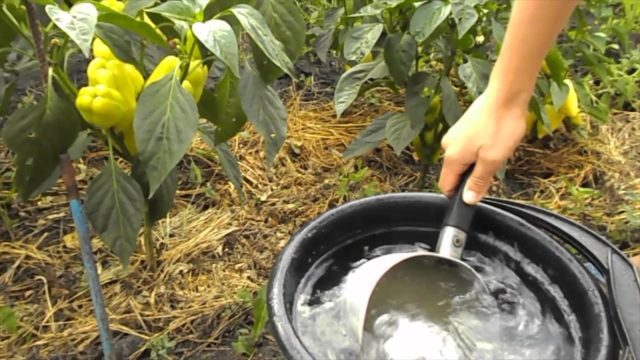

Fertilization rates depend on the composition of the soil
Why choose manure as fertilizer
Folk wisdom
Those who do not want to use preparations containing a large amount of chemicals for their garden, but love beautiful, lush flowers and strive to grow them, prefer manure as a fertilizer. Compared to other top dressing, manure is inexpensive, and if you have your own barn, it is free. Its only drawback is its specific smell.
Fresh manure is not recommended to be used untreated to increase soil fertility. Liquid fresh faeces are used to make mullein solution. When digging the soil, rotted manure is added. The longer the excrement is stored, the better the quality of the organic feed. To grow flowers, humus or mullein solution is often used. Horse and cow manure, bird and rabbit droppings are suitable for feeding flower crops.
Video "Manure as fertilizer for flowers"
Feeding rates
An excess of useful components in the soil can be more harmful to crops than a lack of them. Fertilization rates depend on the composition of the soil and the type of crops grown. For poultry droppings, rates can be calculated both per unit area and per plant.
For each crop, as a rule, a recommended range for the amount of fertilizer is indicated. If possible, you should adhere to the lower limit of this range, and if necessary (the appearance of signs of nitrogen starvation), additional feeding should be carried out. This will not only reduce the risk of overfeeding the plants, but also reduce the cost of fertilizers.
Specificity of use
The unparalleled concentration of useful microelements in chicken manure has a downside. It can be applied in fresh undiluted form only in micro doses, it destroys the root system of most cultivated plants. Even liquid top dressing from chicken should be applied between the rows or holes in the beds, watering the plants themselves with it can damage their root system.
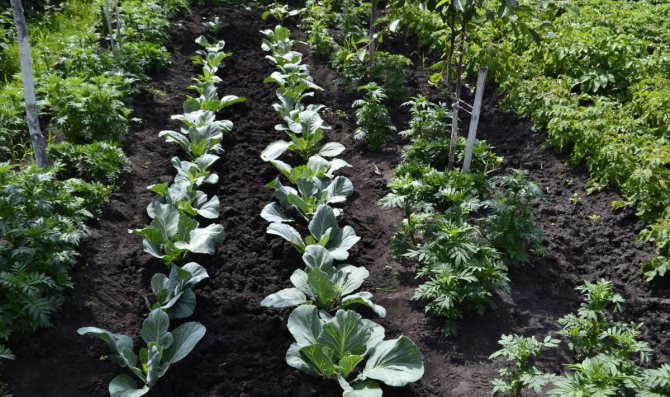

Watering with manure should be carried out between the rows of plants
Experienced gardeners recommend doing this only after watering or good rain, so that the moisture that has got into the soil would further dilute the concentration.
Video - Making fertilizer from chicken manure
Chicken bed
Chicken coop litter is very useful in plant growing. It contains all the beneficial substances of chicken manure, plus straw. Chicken owners can take care of making the bedding even more beneficial for the plants. To do this, it is enough to use substances useful for plants for the lining of the chicken coop. Sawdust will have to be abandoned - they are of little use.
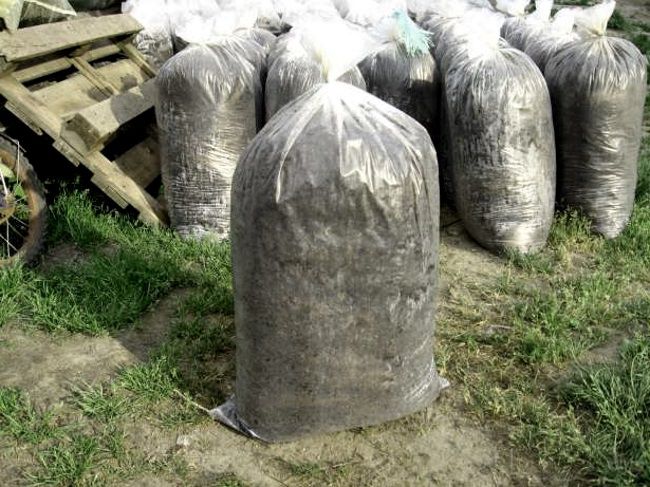

Litter in bags
It is best to use peat. Straw or old hay is also acceptable. You can add a little ash, mixing with residual plant residues and excrement, it will complement their effect. In the practice of gardening, chicken bedding is either put on compost, or used to fertilize the following crops:
- Mulching berry bushes.
- Fruit trees. Litter is poured into the trunk circle at the rate of 1-2 kg per tree.
- Application for cucumbers, zucchini, pumpkins and melons. Fresh litter is mixed in half with the soil and brought before winter to the beds where these crops will grow.
Despite the fact that the litter is usually a mixture of excrement and plant matter, you should not throw it on bare roots, only on the soil.
Application of fresh droppings
Contrary to popular belief, you can also use fresh chicken manure to fertilize your garden.But it must be borne in mind that in comparison with animal manure and humus, it is extremely concentrated. Therefore, the dose should be less.
You can add no more than a glass of fresh or 2/3 cup of dried droppings per square meter of a garden bed. At the same time, it is not necessary to pour it directly under the roots.
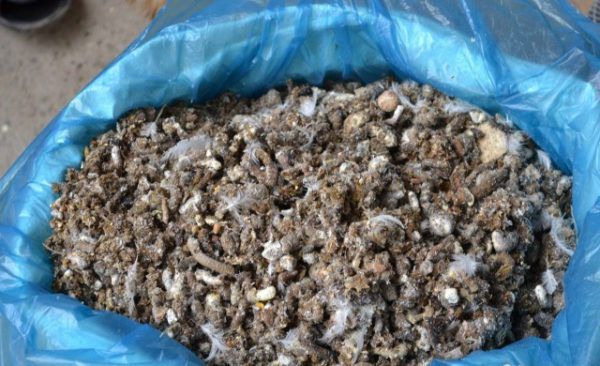

Fresh chicken droppings
In order to more evenly distribute the droppings over the entire area, it is often mixed with sand, ash, peat and other organic and inorganic substances useful for this type of plant. You can also mix fresh droppings with garden soil in a 1: 1 ratio, but even this should be used with caution.
Liquid dressing
For these purposes, fresh chicken manure is taken, which is diluted with clean water. There is no consensus among experienced gardeners about concentration. There are options from 1:10 to 1:20.
How to make liquid top dressing (option 1)
Step 1. The solution obtained by mixing chicken manure with water in a ratio of 1:10 to 1:20 (the concentration varies depending on the plants and the goals of the gardener) is thoroughly mixed until smooth. In color, it should resemble weakly brewed tea.
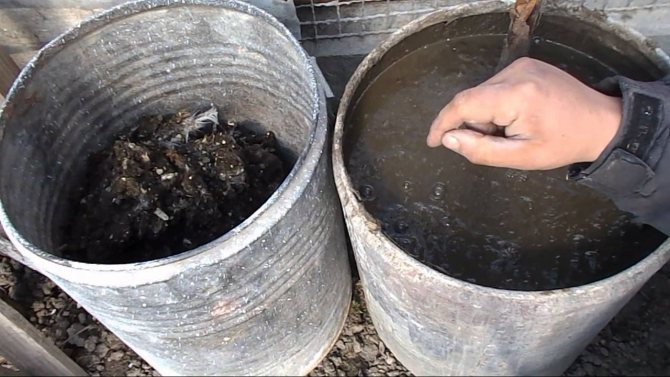

Mixing chicken manure with water
Step 2. The solution is kept for two days in a dark place.
Step 3. Shake until smooth.
Step 4. Dilute in half with water and use for irrigation at the rate of 1 bucket per 2-3 square meters of beds.
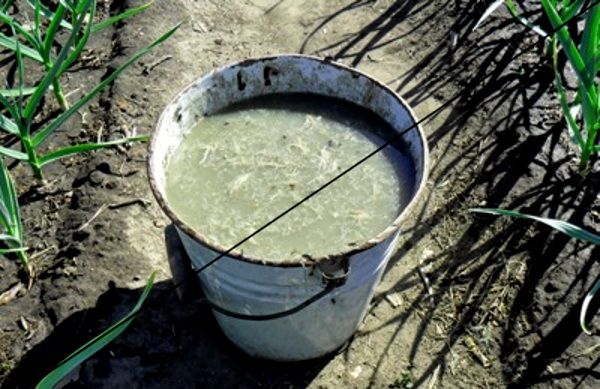

Liquid feed from chicken manure
How to make liquid top dressing (option 2)
Top dressing from fermented droppings has proven itself well.
Step 1. Dilute fresh droppings in half with water in a large resealable container, such as a barrel or garden bucket with a lid.
Step 2. Close tightly and leave for 3-5 days.
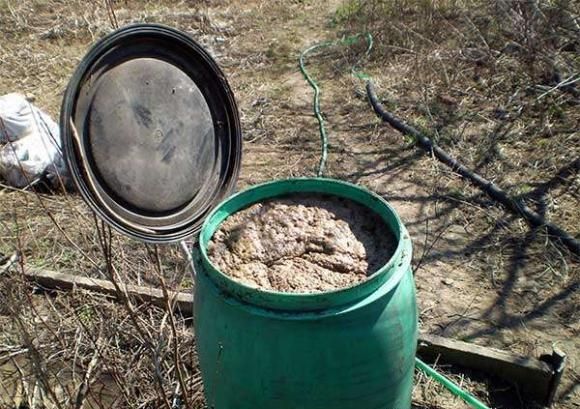

Fermented Chicken Dung Infusion
The result is a liquid concentrated fertilizer. It cannot be used undiluted. In order for the solution not to damage the plants, but to stimulate their growth, 2 glasses of concentrated infusion are poured into a bucket of water.
How to make liquid top dressing (option 3)
This recipe is suitable for watering plants that do not like excessive acidity.
Step 1. Two parts of the droppings are poured with one part of water, and insisted without stirring for two days. For convenience, you can use a cloth bag, so that excess moisture does not have to be separately filtered after the droppings are infused.
Step 2. After that, the water is carefully drained, if you did not use the bag, otherwise, just remove the bag from the container - the excess water will drain off by itself.
Step 3. Then, 1 liter of the resulting slurry is stirred in 20 liters of water and left to ferment, uncovered, for a week. It is not necessary to dilute this tincture with water before use.
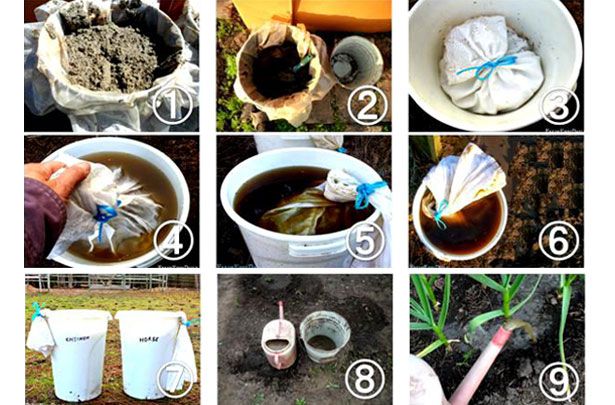

The sequence of preparation of top dressing - option 3
Top dressing with any manure infusion should be done after watering or heavy rain that has well moistened the ground. This will help the nutrient fluid to be evenly distributed in the soil layer and prevent over-concentration, which is harmful to the root system.
All infusions can be used from the moment the plants are planted, they are finished to apply 2-3 weeks before harvesting. If some parts of the plant are eaten all the time, like lettuce or parsley, then these plants are not watered with manure infusions. Application rate - 1/2 -1 l per plant.
Humus
The easiest way to prepare humus from manure in a compost pit. A layer of any plant waste (this can be garden weeds, sawdust, peat, straw, etc.) and droppings are alternately laid in the pit. It is permissible to combine it with other "varieties" of manure, especially horse and cow. The height of the layers should be approximately 20 cm. Thicker layers of excrement do not need to be made, as this can lead to fire. If the manure is excessively dry, the compost pit should be moistened.The pile is covered with a greenhouse film, oilcloth or in another way, preventing the access of atmospheric air. After 3-4 months, the compost is ready.
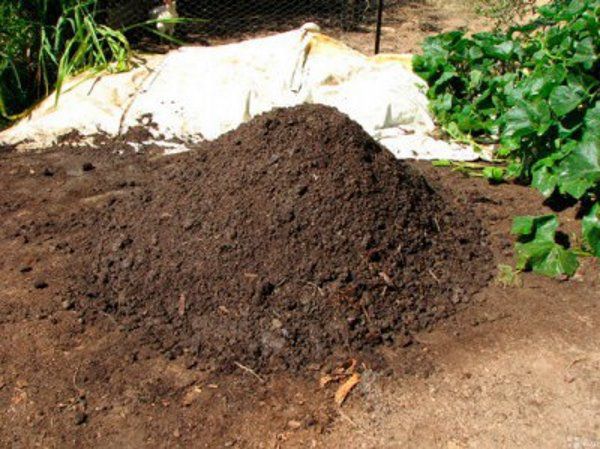

Ready humus
It is easy to understand whether the litter is overrun. If the smell of ammonia, which many compare to ammonia, persists, then the process of overheating has not yet been completed. The stronger the smell, the fresher the droppings. Overripe in smell should not differ from ordinary compost.
Granulated
Granular, or, as it is also called, dry litter, can be bought in agricultural stores or markets. Some gardeners are suspicious of it, considering it "chemical". This prejudice is not true. In the production of chicken manure, third-party additives are not used.
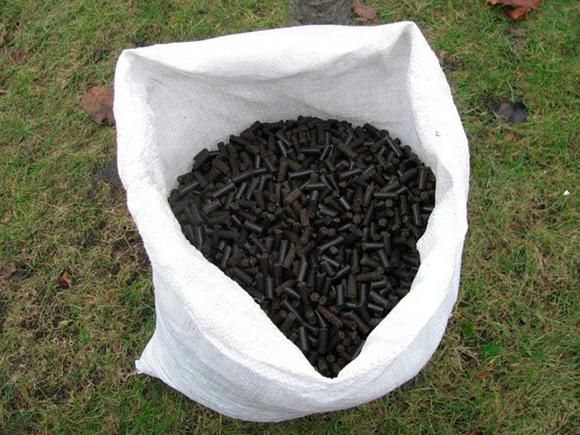

Granular chicken manure
The technology is simple. Fresh droppings, cleaned of dirt and impurities, are heated to 600 degrees. This removes not only moisture, but also odor, and also kills weed seeds, bacteria and microorganisms. After heating, the dried droppings are formed into granules and packaged.
In addition, recently, a new technology of low-temperature dehydration has been applied, which makes it possible to obtain dry manure without heating to high temperatures, i.e. with 100% preservation of nutrients.


Dehydrated manure is as good as fresh
There are no drawbacks to granulated droppings, the advantages include: the absence of odor, bacteria and weed seeds.
How to breed and use droppings for plant nutrition
As mentioned above, the use of poultry droppings requires great care. Due to the high concentration of urea, fresh droppings are not used as fertilizer, because plants can die due to burns. But even at home, you can easily make an excellent fertilizer from poultry droppings.
Cooking infusion from fresh manure
Since fresh poultry manure can be used as fertilizer only in the fall after harvesting before plowing a plot, consider how to make fertilizer from poultry manure. To process poultry manure into fertilizer, an infusion is made.
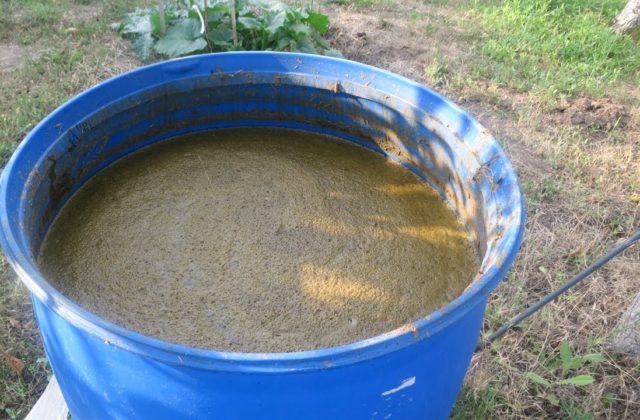

For two to three days, an infusion of bird droppings is prepared
How to cook, i.e. to properly dilute and insist bird droppings for fertilization? There are several options:
- The tincture is prepared in a closed container for two to three days. In this case, the droppings are dissolved in water in a proportion of 1 liter per bucket of water. The resulting concentrate is dissolved to the required consistency.
- A better fertilizer is obtained with complete fermentation of the infusion. This process takes up to two weeks. The end of fermentation is indicated by the cessation of gas evolution (the appearance of bubbles). The proportions are the same as in the previous method.
- For summer dressing, the fertilizer obtained from the fermentation of manure with green, freshly cut weeds is effective. To obtain a concentrate in a bucket of water, dissolve 0.5 kg of manure and put 2-3 kg of green mass. Weeds with ripe seeds cannot be used.
Regardless of the manufacturing method, the concentrate must be diluted with water in a ratio of 1:10 or more. Too much droppings in the finished solution can damage the plant root system.
We breed dry chicken droppings
You can use dry bird droppings, like fresh ones, for the preparation of fertilizers in the form of infusions. The technology and proportions are completely the same. You can also use dry bird droppings as fall fertilizer while preparing your site for spring planting. Depending on the type of soil, the amount of dry litter is calculated from 0.5 kg for chernozems to 1 kg for sandy and clay soils per 1 square meter.
Composting
Composting is one of the most effective ways to obtain fertilizer from poultry manure.To obtain compost, manure is placed in layers about 5 cm thick, alternating with layers of peat or plant waste (15-20 cm) and earth (up to 10 cm). It is possible to accelerate the production of compost and improve its quality by using biological products such as Baikal.
The ready-made compost is used in the same way as the usual plant compost, but in a slightly smaller amount.
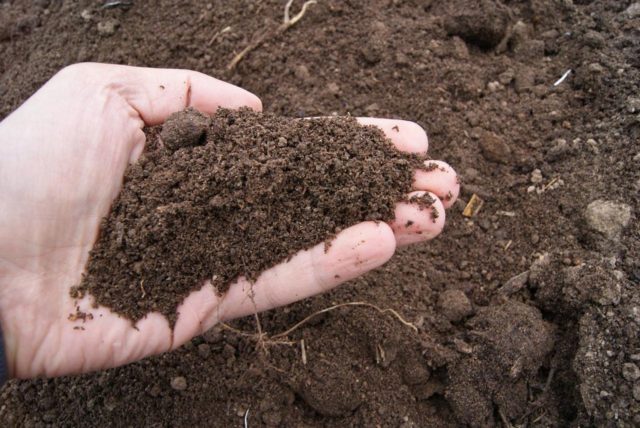

Composting is one of the most efficient ways to obtain fertilizer
Instructions for the use of granulated manure
For gardeners and gardeners who do not contain poultry, granulated chicken manure is industrially produced. Thanks to special processing, it retains its beneficial properties and does not have an unpleasant odor.
Granulated poultry manure can be used as a fertilizer by introducing granules into the ground (up to 300 g per 1 m2) or dissolving in water like ordinary dry droppings.
How to make fertilizer from cow dung
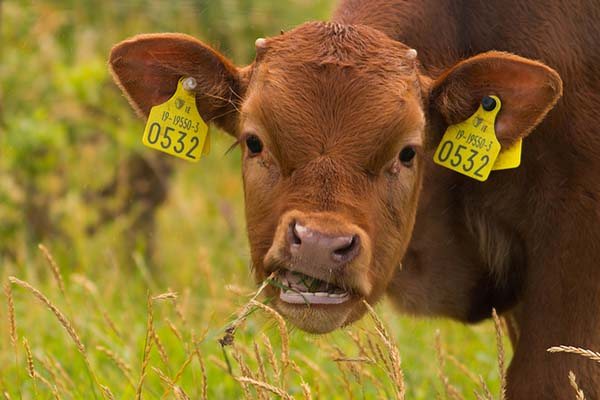

Many flower crops benefit from mullein fertilization. Top dressing should be done before flowering. There is nothing complicated in its preparation.
To do this, you need to take liquid manure and fill it with water in a barrel or deep vat. One bucket of cow waste requires five buckets of water. It is desirable that the container with the contents be located away from the living quarters - the barrel will emit a very unpleasant odor. You can put the barrel on the outskirts of the garden. It takes two weeks to infuse mullein. It is recommended to stir the contents every day, bubbles should appear. After 14 days, the solution becomes light and mullein can be added.
How to use mullein
For more nutrient saturation of the solution, it is recommended to add wood ash and eggshells to the mullein. The value of the mullein corresponds to the nutrients that the cow consumed. For flowers, cow dung is considered the best fertilizer.
- The cooked mullein must be diluted with water. The ratio is 1: 2. At higher concentration, there is a possibility of burning the roots.
- Dig small grooves around the flowers without touching the roots. Pouring plants directly to the base of the plant is not recommended, you can burn the root system.
- Water the flowers before feeding the mullein.
- To make the plants bloom faster, they can be sprayed with mullein infusion with water. The proportions are 1:20. This method additionally protects against pests and diseases.
How to apply cow dung as fertilizer in spring
Fresh excrement should not be added to the soil just before planting. It is best to prepare a compost heap in the fall based on cow excrement and waste (wilted grass, leaves, sawdust). In spring, such compost will be an ideal fertilizer for roses, peonies, dahlias, lilacs, lilies, nasturtiums, marigolds. When forming a flower bed, compost must be placed in each hole for a plant and mixed with soil.
Overripe cow dung can be used for digging not only in the fall, but also in the spring.
How and how much to store fertilizer
Under the influence of moisture and atmospheric air, various chemical processes constantly occur in bird droppings, which do not always improve the properties of fertilizer. Dry and granular manure is best stored in bags or boxes in a dry room, so it does not lose its quality for several years.
Semi-liquid fresh droppings are dried or placed in compost heaps. It is better not to store the prepared liquid dressings, but to use them immediately so as not to provoke the reproduction of harmful fungi and bacteria.
Benefits of using manure when growing flowers
When organic matter is introduced, the acidity of the soil decreases, its structure improves, and the air and water regime normalizes. When organic matter is decomposed, carbon dioxide is released and heat is released, which creates ideal conditions for the development of healthy flower roots.Fertilized with manure, the soil has a harmonious balance of useful elements, the development of soil microflora takes place. Earthworms multiply faster in humus and increase soil fertility.
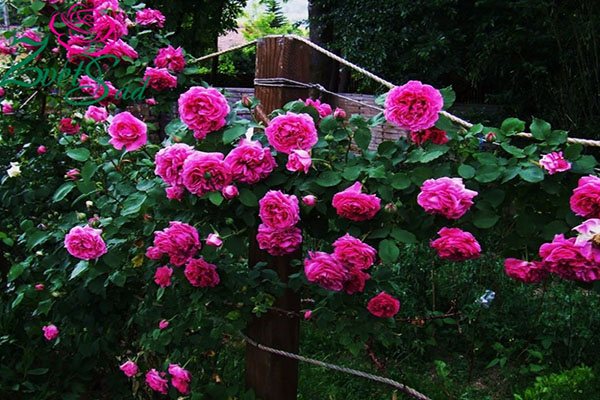

Rose "Mme Isaac Pereire" World awards: about 20 certificates of various shows and competitions USA 1999-2001; title "Best Fragrant Rose" Canadian National Rose Society, Canada, 1999.
Manure is rich in nutrients: nitrogen, phosphorus, potassium, trace elements
- Phosphorus and potassium contributes to the development of roots, the resistance of flower crops to the negative effects of the environment. Flowering depends on these substances.
- Trace elements are necessary to increase soil fertility.
- Nitrogen promotes the growth of leaves, but if it is lacking, the plants get sick.
To obtain the best fertilization, animal excrement must be re-milled in a compost heap for 2 years. It is important not to overdo it with the introduction of organic matter - diseases develop in flowers from an excess of fertilizing. With optimal amounts of organic fertilizer for the soil, a stunningly beautiful garden with lush flower crowns can be grown.
Litter composition and properties
The composition of chicken manure contains mineral elements that improve the structure and increase the nutritional value of the soil. Their introduction creates the basis for laying the future harvest.
- Nitrogen accelerates the growth of young shoots, promotes the growth of green mass.
- Phosphorus is an organic compound that is quickly absorbed by crops, strengthens the root system of plants, increases their resistance to adverse weather factors, and ensures full fruit ripening.
- Potassium regulates the water balance, activates the enzymes responsible for the formation of aromatic substances, increases the frost resistance of plants and helps to preserve the harvest.
- Magnesium is an essential element for the accumulation of chlorophyll. Improves the absorption of phosphates.
- Copper and iron increase resistance to disease and prevent fungal attack.
- Zinc increases the content of vitamin C, proteins, carotene, carbohydrates in plants and promotes root growth.
- Manganese is necessary for the normal course of photosynthesis, contributes to an increase in the amount of chlorophyll in the leaves, the synthesis of sugars and ascorbic acid.
- Cobalt improves product quality and productivity.
- Calcium affects the texture and acidity of the soil.
- Sulfur promotes the absorption of nitrogen, helps crops adapt to climatic conditions.
- Boron accelerates the growth of roots and shoots, makes nitrogen and calcium more available, thereby ensuring a balanced diet.
Fresh chicken manure is a highly concentrated fertilizer that belongs to the 3rd hazard class.
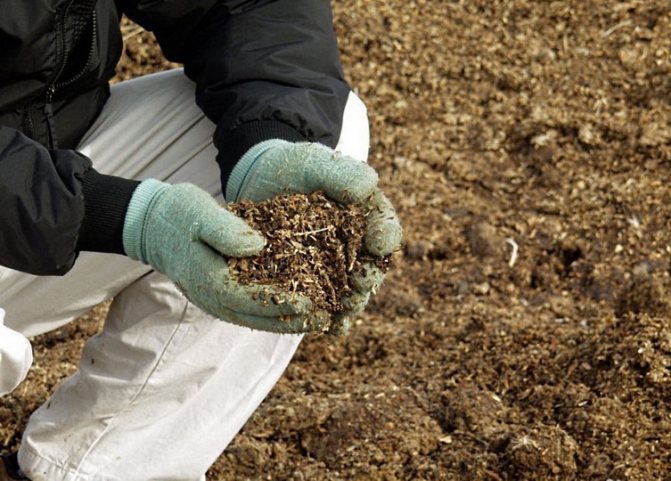

Advantages of using
Chicken droppings contain all the elements necessary for plants, and in the required volume and combination. In the soil, organic matter turns into an easily accessible form for plants, and as a result of the activity of microorganisms that process it, the content of nutrients only increases.
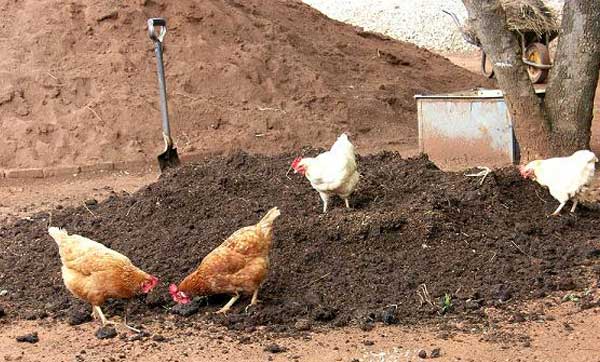

In terms of its effect on plants, droppings can be compared with the best mineral fertilizers, but, unlike them, nitrogen and phosphorus in it are in an accessible form, do not form harmful compounds, and are better absorbed. The action of the manure helps to increase the yield within 2-3 years.
The advantages of using chicken manure as fertilizer are as follows:
- rapid growth of young plants, green parts of trees and bushes;
- friendly flowering and fruit setting;
- acceleration of their maturation;
- increasing drought resilience;
- increase in yield up to 40%;
- strengthening immunity, increasing resistance to bacteria and fungi;
- alkalinization of acidic soil, an increase in the humus content in it.
This fertilizer is convenient to use, since it contains not only the basic elements, but also microelements that are no less important for the plant, which is why they do not need to be applied separately. It does not poison the soil in the garden, does not accumulate in it, does not contribute to the formation of nitrates in fruits, does not pose a danger to humans, animals, insects.
As you can see, chicken dung has many advantages that make it an excellent fertilizer. Those who keep a bird in the courtyard always have it in stock, therefore it is completely free. Other gardeners need to buy it, but the cost is quite affordable.
Recommended to read
Instructions for use for plants growth stimulator Epin extra
Instructions for the use of succinic acid, solution preparation
How to prepare boric acid solution and spray plants
Instructions for the use of copper sulfate in gardening
Manure
It is one of the best organic fertilizers available. It contains about 21% of organic matter, in addition, there are minerals: nitrogen (0.5%), potassium (0.6%), phosphorus (0.25%), calcium (0.35%). There are also trace elements in the manure. However, these data are approximate and depend on the type of manure and the nutrition of the animal (the richer it is in this or that substance, the better the manure will be in this regard). For example, the largest amount of the three main elements (nitrogen, phosphorus, potassium) is contained in sheep and horse manure. Cow and pig manure are less nutritious and contain more water. For indoor floriculture, we recommend horse manure.
Detailed description of fertilizer preparation
Infusion
From this section of the article, it will become clear how to breed chicken manure for liquid plant nutrition. The basic recipe assumes dilution of 1 part dry manure with 50-100 parts of water. In this case, it is better to pour more liquid, otherwise an insufficient amount of it will lead to burning of the plants. Top dressing is not carried out on dry soil, only after watering or rain. Do not allow the solution to get on the stems and leaves. The application rate is about 500-1000 ml per one bush.
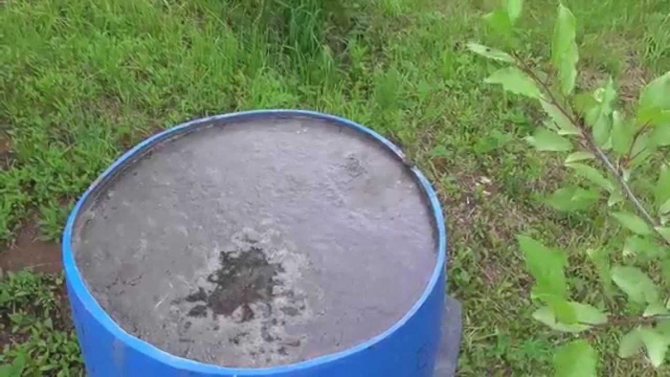

Concentrated infusion is especially popular with summer residents., which is additionally diluted with water when used directly. Its preparation consists in mixing an equal amount of bird manure with water., after which the solution is infused for 2-3 days in a tightly closed container. The condition is mandatory, since this way manure gives up nutrients to the liquid, and the loss of volatile compounds is minimized.
The resulting concentrate can be stored throughout the summer season. For fertilization, 1 liter of infusion is diluted in 10 liters of water. Liquid is introduced between the rows by using a watering can. After the procedure, it is advisable to spray the plants with clean water - this will wash off random splashes from the leaves and shoots.
Compost
With a large chicken coop, the question of how to breed chicken droppings is not the main one. Most of the problems arise with storage, which should ensure the possibility of gradual use without losing useful qualities.
The only option in this case is compost. It guarantees not only storage, but also the enrichment of other organic matter with nutritive components. As the latter, kitchen cleaning, foliage, weeds, tops from plants, rotten fruits and vegetables are used.
The preparation of the pit or boxes must be taken care of in advance. The sizes are chosen arbitrary, strict requirements are put forward only in relation to the depth - no more than 1 meter. If the indicator is exceeded, it will lead to complications in the access of oxygen and all the material will acidify. The bottom of the container is lined with straw or dry leaves. It is also allowed to use sawdust, peat.
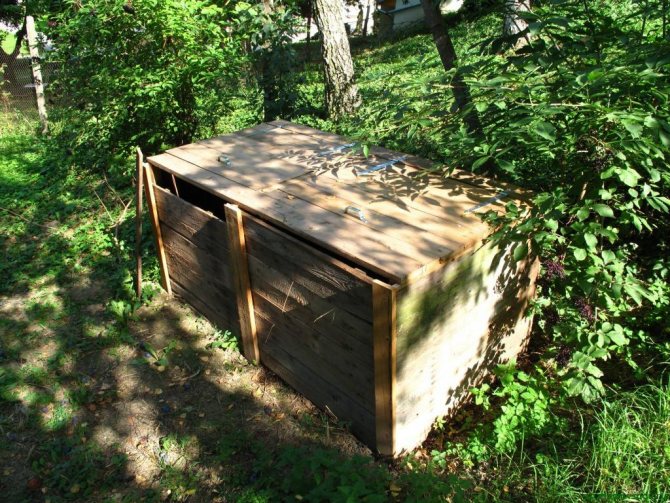

Next, chicken droppings and other organic matter are alternately stacked. Additionally, the layers can be sprinkled with the same materials that were used to refine the bottom. The upper part of the structure is covered from rainwater to prevent the washing out of nutrients and speed up the process.
Under natural conditions, the compost is overheated in at least 1.5 months. To shorten the time, you can use worms or special cultures of microorganisms.
How is it different from animal manure?
The main difference is the much higher toxicity caused by the urine and feces being expelled as a mixture, causing the droppings contains much more ammonia and other aggressive substances.
Therefore, poultry droppings are better suited for the manufacture of liquid feedings, because due to the higher content of trace elements, it more effectively compensates for their deficiency in the plant.
In addition, after drying, the specific content of trace elements is noticeably higher than that of manure, but the content of the organic component is approximately the same.
Combining droppings with plants
As already mentioned, one of the main advantages of poultry droppings is its versatility. The most careful feeding based on poultry manure should be applied under ornamental and floral plants, since they are most sensitive to environmental factors. That is why the concentration of bird droppings when fertilizing flowers should be minimal.
Poultry manure “portions” applied to different types of crops are shown in the table below.
Table 2. Rates of application of poultry manure
| Plant type | Litter manure | Litter-free manure | Details of |
| Up to three kilograms per m2 | Two kilograms per m2 | During the entire growing season, the plant is fertilized two to three times. One copy takes a liter of product |
| Six kilograms per m2 | Four kilograms per m2 | These plants are hypersensitive to burns, so they should be handled very carefully. Liquid top dressing is allowed (5 liters per m2) |
| Three kilograms per m2 | Two kilograms per m2 | Root crops require autumn fertilization. They can also be fed during the growing season with liquid top dressing (4 liters per m2) |
| Three kilograms per m2 | Two kilograms per m2 | Onions and garlic do not always tolerate bird droppings well and are fertilized mainly in autumn. |
| Three and a half kilograms per m2 | Two kilograms per m2 | Green crops only allow autumn fertilization. During the growing season, they are not fed in order to avoid the accumulation of nitrates. |
| Four kilograms per m2 | — | Potatoes are processed only in autumn and only with bedding manure. Does not provide liquid feeding |
| Three kilograms per m2 | Two kilograms per m2 | Strawberries are fertilized with bird droppings three to four months before planting, as well as after the snow melts every three years |
In addition to these crops, poultry manure is an excellent fertilizer for trees. On average, one season per tree takes about a bucket of bird droppings. At the same time, the fertilizer itself is distributed in the near-trunk circles three times during the spring-summer period. You can read about how trees are fertilized with chicken droppings below.


Fertilizing trees with chicken droppings
By the way! In addition to chicken droppings, quail droppings are gradually being introduced into horticulture. You can read about its properties and methods of use in a separate article on our portal.
The introduction of poultry manure under shrubs is also allowed, however, the amount of manure is determined individually, depending on:
- soil properties;
- shrub age;
- type of shrub.
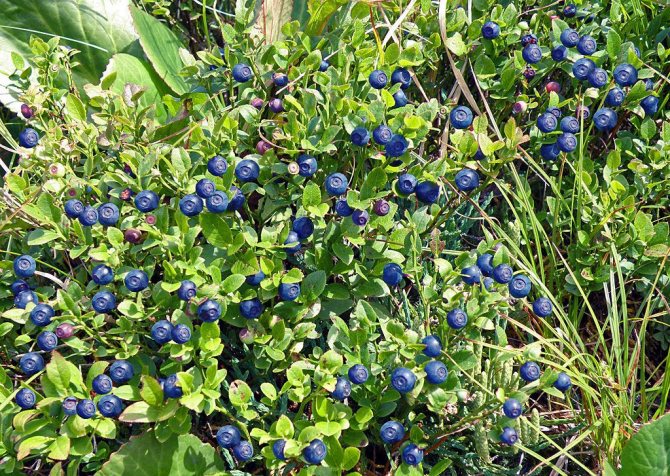

Bird droppings are not suitable for fertilizing blueberry bushes
How to apply in the garden in autumn and spring?
The method of fertilizing the garden in different seasons depends on:
- goals to be achieved;
- processes that will be affected by fertilization;
- availability of fertilizers and means of their introduction.
In the spring
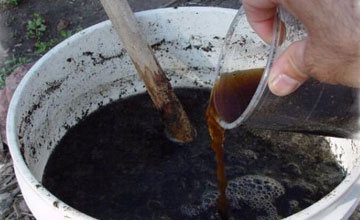

The main purpose of fertilizing the soil in spring is small an increase in the amount of nutrients and trace elements with the help of means that do not affect the condition of the roots or outer covers of plants.
Therefore, fresh and stale droppings can only be used for heating beds or for underground fertilization, when the excrement is separated from the fertile soil by a layer of insulating soil.
You can also use completely rotted liquid top dressing, with which the soil is watered both before planting seeds or seedlings, and after.
Partially ready-made humus is used only for mulching, moreover, retreating from the trunk of the plant by 10-50 cm, so as not to damage its skin or bark. By the time the plant develops rapidly, some of the nutrients from the fertilizer will penetrate into the soil and protect the plant from lack of them.
Completely prepared humus used for:
- fertilizing holes or beds;
- production of soil mixture;
- mulching.
If a little humus is poured onto the bottom of a hole or trench intended for planting seeds or seedlings, then the plant will develop in favorable conditions, which means it will turn out to be stronger. By mixing in equal proportions soil and soil mixture, a substance is obtained that contains more nutrients than the soil, which means that at the moment of active development and fruiting, the plant will not experience a deficiency of nutrients and microelements.
Humus mulching most effective for perennials, because it supplies the soil with nutrients for several years.
In autumn
In autumn, the activity of plants gradually fades away and, they are preparing for the transition to winter mode, therefore, the main purpose of fertilization is to enhance the process of soil restoration. The main participants in this process are humus-forming bacteria and various worms that feed on dead organic matter, converting it into humic acids (humus and vermicompost).
The most effective will be the introduction of fresh or stale bird droppings, which will serve as bait and food for worms, and the vermicompost obtained from it will fill the soil with nutrients suitable for plants.
Moreover fresh litter can only be applied to fallow fields, after all, even taking into account the digging (plowing) of the site and treatment with bacterial preparations, it will take at least a year for complete decay. If you add fresh droppings in the fall, and plant seedlings in the spring, then all the plants will get sick or die due to toxic substances that are an integral part of bird excrement, because bacteria and worms will not have time to process them during the winter.
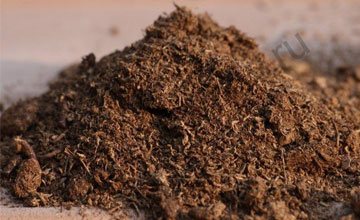

You can also add ready-made or partially ready-made humus in the fall, but it is less useful than fresh or stale droppings, because it does not contain substances that attract worms, and without them the process of soil restoration will be less effective.
Tilling the soil with liquid dressings will only give an effect if green manures were planted first, and then the soil was plowed or dug up along with all the vegetation.
Moreover, the most effective will be top dressing, which in general not exposed to the sun to decay, that is, they are an aqueous solution of droppings. After all, such a top dressing will attract worms that will process plant residues and turn them into vermicompost, which will make the soil more nutritious and balanced.
Terms of use
Fertilizers based on chicken manure can have a different method of preparation, and therefore use. So many gardeners use a mixture of peat (ash), sawdust and leave it to get humus for 1.5-2 months. Without fail, the recycled pile is covered with oilcloth to create a greenhouse effect.
This type of fertilizer based on chicken manure is suitable exclusively for application in the fall after harvest. It is allowed to store the liquid mixture in a concentrated form for up to 4-6 months in a dark, cool place.Before use, dilute with water and give additional time for infusion.
The second mandatory rule for the use of chicken manure was the rule of digging. In whatever form the fertilizer is applied, it will be possible to dig up only after three days. Loosening and puffing is also not desirable.
Terms of introduction
In summer, chicken manure is rarely used. Clean manure is excluded both in summer and spring. During these periods, it is better to use liquid fertilizer in the desired concentration (there is an instruction for the plant).
Rotten manure, compost or fresh undiluted manure is needed for the autumn period to replenish the soil with useful substances, prevent soil freezing.
Consumption rates
Processing chicken manure takes a lot of time. For practicality, it is recommended to use a chicken coop bedding that is laid in the ground. Humus is safe for plants only in the fall. In spring and summer, it is required to dilute for watering.
Dosage:
- humus - 1 sq. m up to 4 kg;
- liquid top dressing: the consumption rate is 1 sq. m = 4 liters.
Precautions
Fertilizing the garden with chicken droppings is useful and necessary to increase the yield. But such fertilization can become dangerous for humans. Reason: unprocessed material may contain pathogens.
Always wear rubber gloves and a respirator to help safe handling of droppings. Even working with dry manure requires compliance with safety standards: inhalation of microparticles negatively affects the respiratory system.
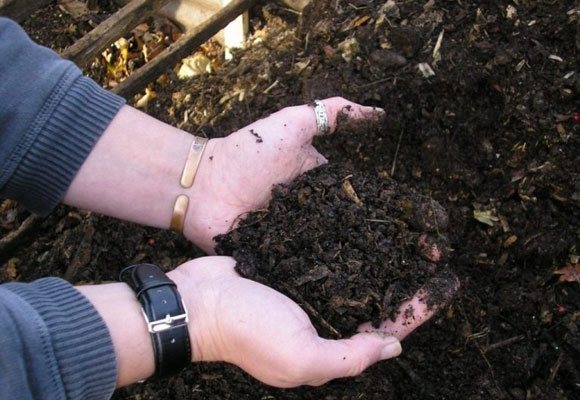

How to use humus fertilizer for indoor plants
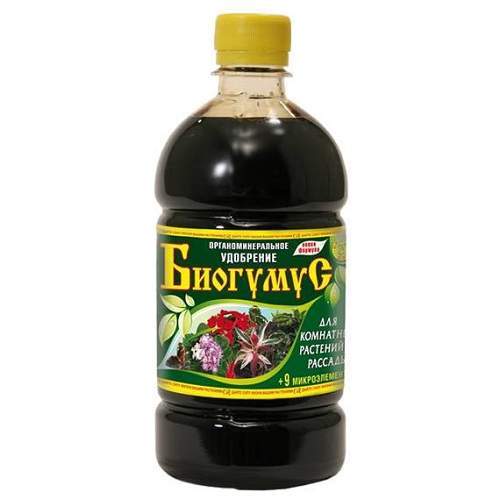

Organic fertilizers are widely used during the period of active plant growth: from the onset of spring to late autumn. Among the ways of using humus are the following:
- Watering and spraying. To prepare a concentrated solution, 1 tbsp is poured into a bucket of water (not cold). humus, stir thoroughly and leave to infuse for a day. The finished solution resembles brewed black tea in color. Before using 1 tbsp. infusion dilute 2 tbsp. water. This solution is used for watering and spraying indoor plants, and the thickness formed at the bottom of the bucket is poured into flowerpots.
- Adding to the soil. Humus has proven itself especially well when growing flower seedlings. Young seedlings grow more actively and get sick less if they are planted in a substrate of 1 part of humus and 2 parts of soil from the garden.
- Soaking seeds in a humus solution for 12 hours increases their germination capacity up to 96%, which is 17% more when compared to soaking in water.
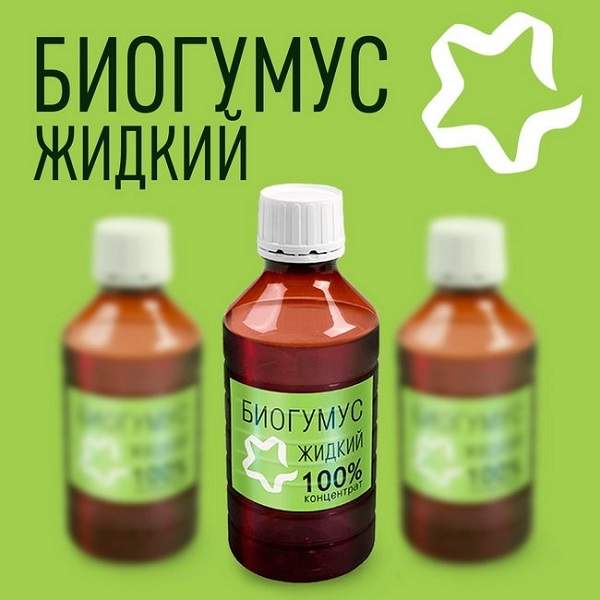

If it is not possible to transplant indoor flowers into new soil every spring every year, they simply renew the topsoil. To do this, carefully select the soil, and in its place pour a layer of pure humus 2 cm thick. You can also pre-mix it with new soil, then the layer becomes thicker.
The use of vermicompost in floriculture - video
Many summer residents believe that manure, as a fertilizer, meets all the requirements for the composition of nutrients. It contains all the necessary substances for the successful development of plants. This organic fertilizer is also valuable because only natural components are characteristic of its composition.
Granular fertilizers
Summer residents who cannot stand the aroma of fresh droppings can purchase a dry version in specialized stores. Granular excrement is odorless, stored for 2-3 years and contains as many useful components as home organic matter.
Together with the dry additive, they buy peat, with which the crushed dung is mixed. The mass is poured into wooden or plastic boxes with holes. The workpiece is placed in a warm ventilated room, where it is stored until the start of garden work. The peat mass is introduced into the holes before planting potatoes or seedlings in order to increase the yield.
Chemical composition
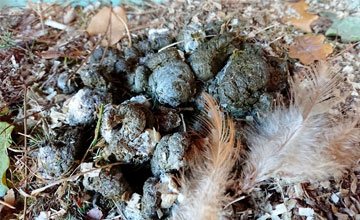

The main components of manure are the same substances as in manure, that is:
- organic;
- intestinal enzymes;
- nitrogen in the form of various compounds;
- phosphorus in oxide form;
- calcium oxide;
- potassium oxide;
- various metals in the form of oxides and salts.
The percentage of each component depends on:
- diet;
- conditions of detention;
- the physical condition and breed of the bird.
Therefore, even in birds of the same breed, but living in different conditions, the percentage of the main components can vary quite a lot... For example, in birds in the diet of which grain predominates, droppings contain significantly more phosphorus, but if the main food is grass, then the nitrogen content increases.
Collection and storage of droppings
The method of collecting droppings directly depends on the conditions in which you keep chickens in the hen house - on bedding or without them. Most farmers use bedding because they keep the air humidity stable in the coop and prevent the spread of bacteria (provided that the bedding is changed periodically).
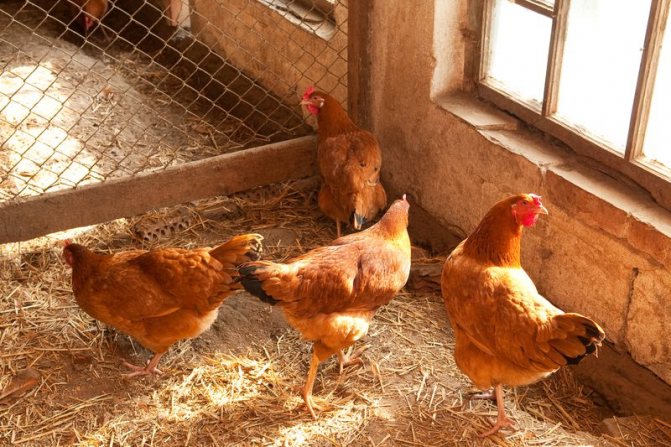

The use of litter in the hen house allows for easy use of the collected manure for composting
So, there are two main methods for obtaining poultry manure:
- when using bedding, the droppings are removed along with straw, hay or sawdust (depending on the material used). Since the volume of such a product will be large, you may need tools at hand in the form of forks, shovels, rakes and one garden wheelbarrow for easy transport of manure;
- Keeping chickens without bedding is less beneficial for the birds, but makes it easier to collect the droppings. All that is required of the farmer is to clean the accumulated waste from the pallets every day and transfer them to a container specially prepared for manure.


It is important to clear excrement from the coop as often as possible to prevent the spread of infections.
Precautions
When working with poultry droppings, it should be remembered that it is far from always safe. Like any other manure, bird waste can contain eggs of helminths and other parasites that can easily pass to humans. If the droppings were contained in the layers of the litter, then various pathogenic bacteria could have gotten in it with a high probability.
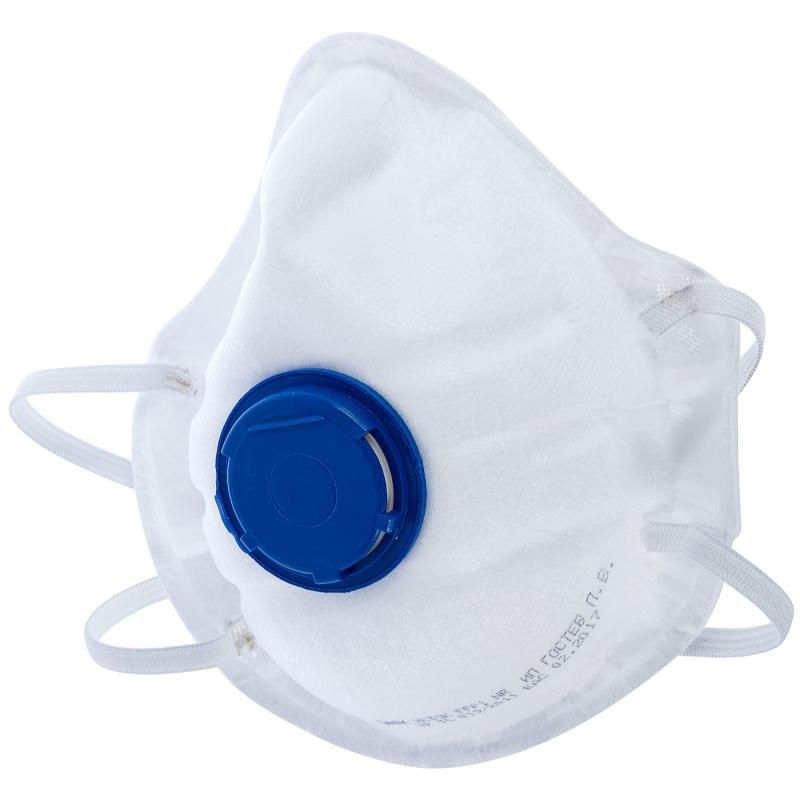

The simplest respirator with a paper filter will prevent the farmer from getting infected from the collected manure
In order not to come face to face with any infections after cleaning the chicken coop, follow a few simple rules:
- Do not work with manure with bare hands - use rubber gloves;
- To prevent bacteria from entering through the respiratory tract, use a respirator, which, among other things, will protect you from unpleasant vapors;
- At the end of the work, all the tools used to collect the droppings are certainly washed and decontaminated, and the clothes you put on are thoroughly washed.
Further storage of droppings
The collected droppings are subsequently either composted or dried. It is most convenient to compost manure that already has a large amount of litter in its composition, since it is a ready-made layer that binds moisture and facilitates the flow of oxygen to the manure. Drying, in turn, is done when you plan to keep the droppings for an extended period of time.
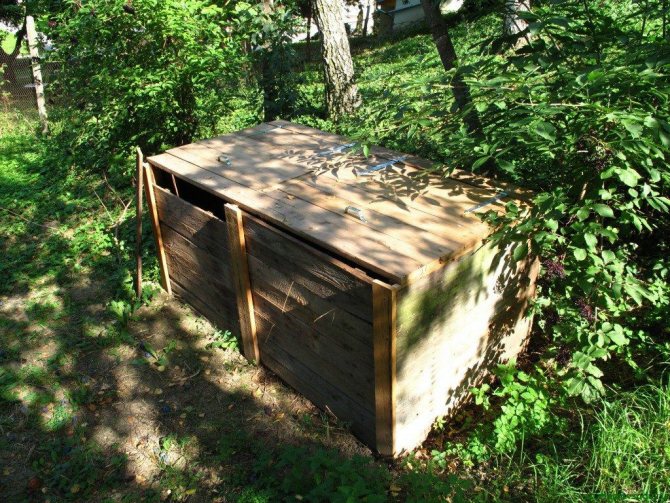

Storing manure in a compost pit
disadvantages
Like any other fertilizer, chicken manure has its drawbacks and contraindications for use.
- It is not recommended to use droppings during the harvest period, as well as when growing so-called “greens”: lettuce, onions, parsley, etc. Their taste can be spoiled by a specific aftertaste resulting from an excess of nitrogen.
- If chickens were on free grazing, their excrement may contain viable eggs of worms and seeds of plants, including weeds.When applied in autumn, both eggs and seeds do not completely die during the winter.
- Chicken droppings contain arsenic, albeit in low concentrations. It is not enough to cause poisoning at the frequency and volume of use recommended in this article, and even when stored in compost piles. However, when large volumes of droppings are stored in one place for many years and used uncontrolled, such a danger arises. It is worth recalling that arsenic does not break down into components in water and soil, but simply accumulates.
- Chicken droppings contain up to 2% lime, and when decomposed, it releases up to half a cubic meter of methane-containing gas from each kilogram. Therefore, it is important to avoid overdoses.
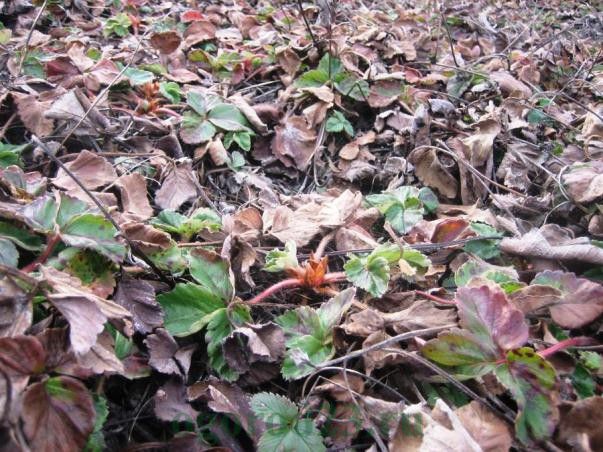

Fertilizer pre-dosage leads to plant death
- May contain bacteria and microorganisms dangerous to humans, including the causative agent of salmonellosis. If chickens have received large amounts of antibiotics, growth stimulants and drugs, residues of these compounds will also be contained in their feces.
In addition, chicken manure cannot be used as biofuel for greenhouses. It releases large amounts of ammonia, which inhibits plants.
Views
There are 3 types of chicken manure: litter, litterless and dry. They differ in structure and composition.
Litter droppings have a moisture content of 30-50%, free-flowing consistency. Dry peat, shavings, sawdust, and straw are used for litter. In this form, all nutrients are preserved in the droppings, since the litter, acting as a preservative, contributes to their preservation.
Litter-free litter in its pure form is a viscous, unpleasantly smelling mass. It contains a higher concentration of nitrogen and other substances, but also contains weed seeds, microorganisms, larvae and eggs of pests and parasites.
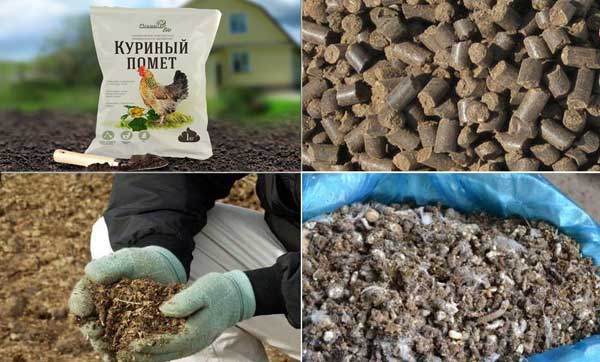

Dry litter with a moisture content of no more than 20% is an organic fertilizer that can be stored in a dry place. It is odorless and can be easily transported.
It is necessary to store the litter correctly: in the open air there is a loss of nitrogen, up to half in 2 months. To reduce losses, you need to dry or freeze the raw material or mix it with sawdust, straw, peat (1 to 1), superphosphate (6-10%).
It can also be composted with peat and straw, plant residues, grass, vegetable tops. It cannot be stored outdoors, it dries up, nitrogen is lost, its value for vegetable crops is rapidly decreasing.
Content of nutrients
Fertilizer based on chicken manure has long been considered one of the best ways to provide the soil with essential trace elements. It supplies plants with useful substances for four years, and begins to act as much as possible after 7 days after being introduced into the ground. The fertilizer contains the following substances:
- iron - 0.3%;
- copper - 3 mg / kg;
- nitrogen - 4%;
- potassium - 2%;
- magnesium - 0.3%;
- zinc - 22 mg / kg;
- phosphorus - 2.5%;
- manganese - 300 mg / kg;
- cobalt - 3 mg / kg.
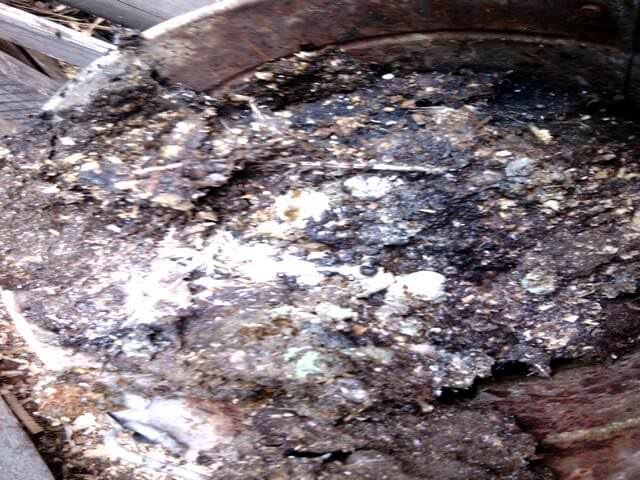

Feeding cucumbers with droppings
How to apply chicken droppings? Top dressing of cucumbers is carried out several times. To do this, use a liquid solution of bird droppings, the color of tea leaves. The first feeding with chicken droppings is carried out when the first leaves grow back, then, when the cucumbers bloom, the final one - during fruiting.
Cucumbers will yield a good harvest if the garden bed is covered with ready-made manure-based compost. He will be able to provide food, the necessary moisture, improve the composition of the soil. During the fruiting period, top dressing along the leaf and at the root is important. Water the plant after each feeding.
Testimonials
- Irina, 43 years old: “I have a fairly large plot at my dacha. I love growing vegetables and I have a big garden. But I want to say that taking care of all this is quite difficult. To feed my crops, I do not buy expensive fertilizers, I use chicken manure. I buy it because I don't keep chickens. I mix it with straw and apply in the fall. In the spring, the garden is dug up and the plants are planted.With this top dressing, I saturate the soil near the trees with nutrients. I have been using this method for a very long time, 6-7 years. Thanks to feeding from poultry droppings, I always have a high yield. "
- Kirill, 32 years old: “I use poultry manure, which is sold in granules, to fertilize my garden. It doesn't smell and yet is just as effective. I mix the granules with water and water the soil 2 weeks before planting the crops. When preparing the composition, it is important that it is not too concentrated, otherwise the plants will get burned. If everything is done correctly, you can get a high yield. We managed to collect a lot of cucumbers and tomatoes, which was enough for conservation and even shared with relatives. "
- Anna, 28 years old: “At the dacha, my mother and I use bird droppings to feed some crops. We do not have to buy it, since the neighbors keep chickens in large numbers and give us their droppings just like that, since they do not have a vegetable garden. We add ammonium nitrate, sawdust and peat to the litter. The resulting mixture is very nutritious, thanks to which the plants receive the components necessary for growth and development. "
Chicken manure is one of the most effective and well-known fertilization options. It can be used in combination with other mineral and organic ingredients for maximum results. Anyone can make a formula. You just need to follow the recommendations above.
In what proportions and how to insist chicken droppings
Fermented fresh manure is also used as top dressing. Take a container in which the droppings and water are bred in half (1: 1 ratio), tightly closed with a lid, and allowed to ferment for several days. Readiness is determined by the characteristic bubbles on the surface.
Then the fermented mixture is diluted with water. For 1 bucket of water, add 1 liter of fermented infusion and fertilize the plants with this working solution. The advantage of this infusion is that it can be stored throughout the growing season and not deteriorate.
How to choose a composting method
If the plot is large and you need a lot of fertilization, then it is recommended to build two types of composter: fast and slow. In this case, the aerobic composter is best done with three compartments:
- For laying a new batch of raw materials.
- For maturing compost.
- For transferring mature compost from one bin to another.
While in the pit an even more nutritious anaerobic substrate will be prepared, for the preparation of which no human intervention is needed. Such a fertilizer preparation system is essential, when there is a lot of raw materials for composting:
- garden tops;
- dry leaves of fruit or ornamental trees;
- coniferous litter;
- lawn grass;
- weeds;
- chicken or other manure.
Surely, if the owners breed chickens, then they have other poultry or animals, whose waste will also be used to make plant food.
Feeding strawberries with droppings
How to properly feed strawberries? In the spring, the beds are watered with a liquid infusion of fresh bird droppings. Feeding can be done no more than once a year. The solution should be of low concentration (1:20), they spill the aisles, trying not to get on the leaves. Such watering is carried out before flowering, while young leaves are growing. The nitrogen in the droppings will help plant flowers and grow green mass. 1.25 liters of solution are poured under each bush. Top dressing of strawberries in the fall occurs during digging, fertilizer is applied to the soil.
The history of the use of poultry droppings goes back to ancient times. How many chickens are bred by humans, so much of their droppings helps to get rich yields. Even a novice gardener can use natural fertilizer.
Is it possible to fertilize roses and other plants with chicken droppings
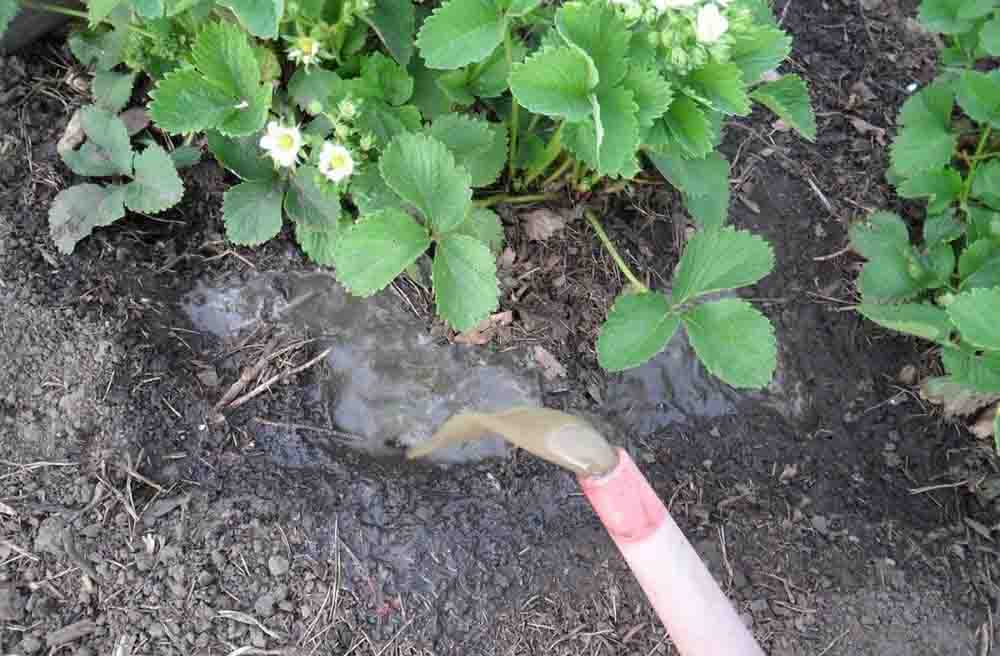

The use of this type of dressing for roses is allowed. Nevertheless, this type of fertilizer is not very popular among flower growers.This is all connected with the ability to burn plants or add excess nitrogen. Therefore, the introduction of chicken droppings is carried out during periods when roses are in great need of nitrogen. Incorrect application will lead to a decrease in disease resistance. It is necessary to observe a strict dosage, otherwise exceeding the concentration will have a bad effect on the plants, which will lead to their oppression.
During the flowering phase, feeding with chicken droppings is not recommended. The last period in which top dressing can be carried out is the budding phase. After it, the use of this product as a fertilizer must be excluded.
You can not feed young seedlings, as well as plants affected by diseases.
In addition to roses, other agricultural and decorative crops can be fertilized with the waste product of chickens. There are no particular contraindications.
Important! Chicken droppings have a great effect on the yield of grapes, potatoes, strawberries, tomatoes.
Granulated chicken manure - instructions for use
The packaging purchased in the store contains instructions for use. Always read it before use. However, I will explain in more detail how to use fertilizer in different situations.
- Dry dressing... Spread dry granules (whole or crushed) over the entire surface of the beds at the rate of 150 g per 1 in. m., lightly cover the soil with a rake. But in no case should the granules come into contact with plants or the root system. Because the fertilizer, I repeat, is very concentrated, it can burn the plant and spoil it.
- Liquid top dressing... 1 kg of granules (amount in a bag) need to be poured with 3 liters of water, leave for a day so that the granules swell. The resulting solution is diluted in 20 liters of water and the plants are watered with this fertilizer, spending 0.5-1 liters for each, depending on the size of the plant.
Advantages and disadvantages
Bird droppings have been repeatedly studied, trying to prove the uselessness of the folk method of plant protection. But the facts obtained have convinced scientists that organic feeding has a huge number of positive aspects.
One of the first positive qualities was called the ability not only to absorb well into the soil, but to feed the root system for a long time. Nutrients remain in the soil even after heavy rainfall. No other chemical fertilizer can boast such a powerful advantage. In addition, the pluses include:
- The cost is much less than other organic and chemical fertilizers.
- Improving the properties of the soil, does not burn the roots and accelerates the growth of fruits.
- useful properties of proteins, minerals, vitamins and other substances of the fruit are doubled. At the same time, vegetable and fruit crops perfectly tolerate rainfall and drought.
- It is not toxic and does not pose a fire hazard.
- Helps to strengthen the protective functions against infections (fungal and bacterial).
Application
How to use chicken manure in the garden? Since the concentration of nutrients in chicken manure is very high, it must be used very carefully. An overdose of chicken can destroy the root system of plants. To protect the seedlings from burns, the aisles are watered with a liquid solution.
Terms of use:
- seedlings should be watered in cloudy weather or at sunset / dawn;
- before applying top dressing, the beds should be well watered, it is not recommended to water dry soil;
- contact of dry droppings / granules with the roots of seedlings is unacceptable;
- if the solution gets on the leaves of seedlings, it should be washed off with water.
How many times per season and how to use chicken droppings? Gardeners do not recommend treating seedlings with chicken more than 4 times a season.
Autumn digging
Autumn application of rotted chicken manure is recommended on soils with a heavy composition. During the winter period, soil microorganisms will process raw materials, converting them into components that are easily assimilated by plants.How to fertilize the soil with chicken droppings? It is necessary to spread humus evenly over the site (per hundred square meters - 1 kg of fertilizer) and dig it up.
Consideration should be given to the condition of the raw materials. If you are using dry compost, take a little less than a kilogram. If you are using wet raw materials, take a kilogram. Chicken can be applied to the soil along with ash and other fertilizers. It is allowed to simply scatter the chicken over the site without digging.
Important! Copper sulfate can eliminate the unpleasant odor of droppings. About 300 grams of chemical is consumed per barrel with fertilizer.
Fertilization in early spring
In the spring, chicken droppings are fertilized with light-textured soils. You can add chicken before the spring digging of the site, when the beds are marked. In this case, the rotted fertilizer is scattered in an even layer (1 kg of humus is taken per hundred square meters) and dug up.
You can add chicken before planting seedlings. In this case, the raw material is mixed with straw and laid out in the aisles.
Note! The use of fertilizer from fresh droppings during the ripening period is unacceptable: you can become infected with helminthiasis.
Fresh litter
Fertilizer is applied at the rate of 1 glass per square meter. If dry litter is used, half a glass is sufficient. In no case should fertilizer be poured under the roots of plants - only around the hole or in the aisle. To evenly distribute the chicken over the soil, it is pre-mixed with ash or peat. You can also mix the droppings with sand or other organic / inorganic substrates, including regular soil.
Dry chicken
This type of litter is used in autumn or spring. Chicken droppings are used in the fall before digging - first, the substrate is scattered on the ground, then dug up. Dosage: 5 kg of droppings per 5 m2 of land. It is recommended to use compost in spring.
Making liquid feed
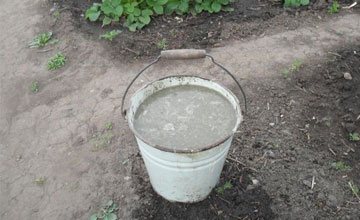

Making liquid plant food from chicken droppings consists of the following stages:
- soak;
- infusion;
- filtration;
- breeding.
We will analyze each of these stages in more detail.
How to soak and how much to infuse?
Soaking accelerates decomposition, because in a liquid medium, the solid particles of the droppings are soaked and converted into a paste, thereby facilitating the access of bacteria to organic matter.
A little water is added to the droppings to soak. Before soaking the droppings for feeding plants, you need to determine the volume of added liquid, but it depends on the state of excrement.
For 1 kg of manure take:
- fresh - 1-2 liters of water;
- stale - 1-3 liters of water;
- dry or granulated - 2-5 liters of water.
For soaking manure and water placed in a container of sufficient volume and left for several hours... Then the contents of the container are thoroughly mixed and the presence of lumps that need to be crushed is checked. They can be rubbed against the walls of the container or destroyed using a drill attachment for mixing the solution.
After making sure that all the droppings are completely dissolved, the soaked mass exposed to the sun, where she should spend 2-6 weeks, for which the bacteria will completely process toxic substances and turn the mixture into a substance safe for plants.
It is impossible to say unequivocally how much to insist chicken droppings for feeding plants, because you need to monitor the state of the infusion. Fermented means ready to use. The signal for the end of the decay process is the appearance of a persistent earthy smell and the cessation of the release of bubbles. For some work, a partially rotted top dressing is required; the appearance of a persistent swamp smell indicates its readiness.
The ready-made or partially finished mixture is filtered (this operation is needed only if the dressing will be used for spraying the foliage) through multilayer gauze. Before use, the finished mixture is diluted with clean water. to the required concentration.
How to breed dry droppings?
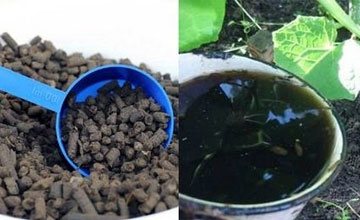

The technology for breeding dry chicken manure differs from that described above only in that its carried out in 4 stages:
- soaked to the moisture content of fresh excrement;
- rub all the lumps;
- add water to dilute to suitability for decay;
- add a bacterial preparation.
Then the infusion is exposed to the sun so that the solution is completely or partially rotted.
Infusion proportions
When making top dressing, it is very important to observe the necessary proportions of infusion and water, because if there is a lot of water, top dressing will not have the desired effect, but if it is not enough, then the fertilizer can burn the plant.
The amount of water per 1 liter of tincture depends on:
- the state of the tincture (partially or completely rotted);
- further application of top dressing.
We have prepared a table in which we have included the most popular ways of using top dressing, as well as proportions to prepare an infusion of chicken manure:
| Mode of application | Liters of water per 1 liter of partially rotted tincture | Liters of water per 1 liter of completely rotted tincture |
| Autumn watering of the field after harvest and before leaving under fallow | 5–10 | 5–10 |
| Spring irrigation of the field under fallow | 5–30 | 5–20 |
| Watering before planting seeds or seedlings | 100–150 | 10–30 |
| Watering planted seedlings | 100–150 | 10–30 |
| Watering during the appearance of flower or deciduous buds | 50–100 | 10–30 |
| Watering during flowering | 150–200 | 50–80 |
| Watering during fruit ripening | 200–300 | 100–150 |
| Watering with a lack of mineral and nutrients | 150–200 | 30–50 |
| Foliage spraying | 200–300 | 50–70 |
How to apply top dressing correctly?
If it is necessary to add top dressing to the soil in a small area, for example, in a vegetable garden, then it is bred in any suitable container, then either pulled out in buckets throughout the garden, or poured into a barrel raised 1–2 m above the ground.
For pumping, you can use any drainage (fecal) pump designed to work with sewage. Then a rubber hose is hooked up to the barrel and with its help the liquid is distributed over the area.
Sometimes the hose is connected directly to the fecal pump, however you shouldn't do this for the following reasons:
- you have to use a thicker hose so as not to increase the load on a very expensive pump, because the thinner the hose, the higher the load on the electric motor;
- you cannot use long hoses, because the longer it is, the higher the load on the motor;
- it is necessary to constantly monitor the pump and turn it off in time so that the device does not idle.
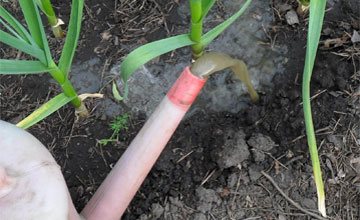

The best tool for watering small areas, such as around a single plant, is garden watering canbecause it provides better fertilizer distribution than hose irrigation.
If one watering can is not enough, then the entire volume of liquid can be immediately brought in several buckets or in a barrel installed on a trailer to a walk-behind tractor or a hand wheelbarrow.
If you have to water not only the soil, but also the plants, then this operation must be performed either early in the morning or late in the evening, because watering in the middle of the day will lead to damage and disease of the foliage.
Garden sprayers are used to spray foliage. Moreover, for processing small single bushes or low trees, you can use small hand-held models, and for processing a large tree or a group of plants, a backpack apparatus with a telescopic extension is better. This spraying should also be done either early in the morning or late in the evening.
Efficiency for garden crops
Chicken droppings for plant nutrition can only be diluted with water. And use strictly according to the "recipe", taking into account the characteristics of the plant, its need for nutrients. In a natural, undiluted form, it will be more beneficial if used in the fall during preparation for winter.
In spring, the soil will be fully saturated with useful substances. Maintain efficiency throughout the growing season. To fertilize strawberries or other delicate plants, the feeding is doubled.Since it is impossible to collect droppings in a home chicken coop without straw or sawdust.
Pigeon droppings as fertilizer
Pigeon manure as a fertilizer practically does not differ from chicken manure. It is successfully used for feeding potatoes and tomatoes. Considered to be more effective than cow dung. It contains a balanced amount of nutrients needed for a good harvest. The action of the droppings on plants is effective and fast.
Pigeon droppings are stored for a very long time without decomposition. It is used in the form of an aqueous infusion, in dry form. Used for composting.
Pros and cons compared to other types of manure
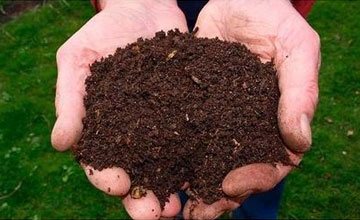

There are no serious pluses or minuses.
In a fresh state, he contains more nitrogenous compounds and other organic substances than excrement of other species due to the fact that it comes out with urine, but after a day this advantage disappears due to the evaporation of ammonia and other processes.
After a week of storage, everything and after reducing the humidity to 50%, the content of all substances comes to the average value for any excrement, because a lot depends on the diet of birds and other factors. After decay all characteristics are even more averaged.
Also, this material cannot be compared with other types of excrement in terms of price and availability, because in one place it will be given away for free, and even they will bring it themselves, and in another you will have to buy it very expensive.
Therefore, for those who have access to free or extremely cheap chicken manure, it is the best type of excrement, but if it is cheaper and easier for someone to buy cow or horse manure, then those materials will be preferable.
Compost accelerators or how to get fertilizer by the beginning of summer
In winter, you can also prepare chicken compost, but they do it in a warm room or insulated. Under natural conditions, it is difficult to maintain a temperature of 60 degrees in winter. To do this, you need to either insulate the composter, or move it indoors.
But even at above-zero temperatures in the barn, accelerators are needed to keep the bacteria alive. Most often used for composting:
- Baikal EM-1;
- Radiance;
- Dr. Robik for anaerobic chicken compost.
These drugs are more expensive, but surpass all similar additives in quality and types of bacteria inside. They do not eat in every city or store, so it is safer and faster to order accelerators on the sites.
Particular attention should be paid to the shelf life of additives and the way they are stored. Baikal, for example, cannot be sent by mail during the cold season, as its efficiency drops sharply.
Video: Chicken Manure Compost with Sawdust
Features of excrement by bird species
Despite the fact that all birds are similar to each other, the droppings of each species differ not only from the excrement of herbivorous mammals, or birds of other species, but even from the droppings of birds of the same breed, but living in different conditions. After all, droppings are formed from the food that the bird eats, which means diet strongly affects the chemical composition of excrement.
Another factor on which the properties of excrement depend is the conditions for keeping birds. After all, the level of physical activity greatly affects the metabolism of a living being and the work of its intestines.
Therefore, we have prepared a brief overview of the characteristics of the litter of the most popular bird breeds.
Chicken
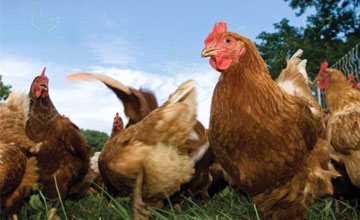

Chickens are the most popular type of poultry, which is characterized by unpretentious nutrition and high fertility, and meat is considered dietary.
Therefore, the main difference between chicken manure is that it much easier to findthan the excrement of other bird species, however, clean droppings occur only in large poultry farms, where all livestock are kept in cages, and their waste flows into the dung bin located below.
In home breeding, birds are kept in special chicken coops, where chickens and roosters sit on perches, and the droppings fall on the litter, which covers the floor, which means that the chicken droppings are litter.
Chemical the composition of chicken excrement is highly dependent on the diet, therefore, where they are often fed grain, it contains more phosphorus, and where the main food is grass and insects living in it, the percentage of organic matter and nitrogen in the droppings increases.
In the farmsteads where a small livestock is kept, either humus is made from excrement, for which it is piled in small heaps and sprinkled with grass, or top dressing.
At poultry farms, due to the large daily volume of excrement, chicken manure can be used in any way that we talked about here.
Goose
Geese are popular due to their rapid weight gain and unpretentiousness, because in households it is enough to release them on the field, where they will independently find themselves most of the daily diet. At poultry farms, they are rarely bred, because for normal development they need to move and periodically swim, which is difficult to organize in the conditions of industrial goose breeding.
When breeding geese at home, droppings are obtained, very high in nitrogen, because most of their diet is grass and various insects.
However, in winter, as well as when grown in a poultry farm, their excrement contains more phosphorus and trace elements, because their main diet is pelleted feed and grain waste.
Quail
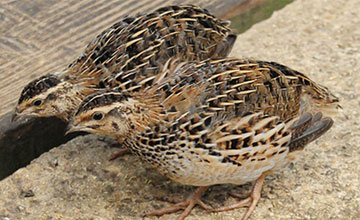

The most demanded product for breeding quails is their eggs, therefore, birds are provided with such conditions of detention in which their egg production increases.
This implies not only a balanced diet, but also the ability to fly, even in the limited space of the aviary, thanks to which their droppings also turns out to be as balanced as possible.
Therefore, the content of organic matter and minerals in their droppings is as close as possible to the average values for all birds, thanks to which fertilizers from quail droppings are also obtained as balanced as possible.
Pigeon
Pigeon meat is not in great demand, therefore, mass breeding of these birds in poultry farms is very rare. But they are often bred on private dovecotes by various bird lovers of this breed.
However, most often pigeons settle on their own under the roofs of old houses with large attics, which determines the place of the greatest accumulation of their droppings.
Despite the small size and scanty daily volume of excrement excreted by one bird, a flock of birds is capable of producing a huge amount litter.
It is quite difficult to find pure pigeon droppings due to the extremely rare cell content of these birds. Much more common stale or dry (after all, it is not always possible to find it quickly) litter manure, and nests often act as litter, which the pigeons themselves make from various vegetation. Therefore, all parameters of pigeon droppings depend on many factors and cannot be compared with the excrement of other birds or animals.
Turkeys
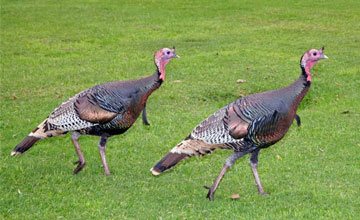

Turkey meat is very tender and low-fat, therefore it is suitable for any diet, and the birds themselves are not too whimsical, therefore they are often bred in villages or suburban houses, there are also turkey farms, which contain thousands of heads of these birds.
However, for normal development and rapid weight gain, these birds need the ability to walk and fly at least short distances.
Like chickens turkeys are omnivorous birds, therefore, the chemical composition of their excrement is highly dependent on the diet.
In households and small farms, turkey manure before use is most often stacked in relatively small heaps (each one consumes all the droppings collected in 1–6 months), and if necessary, they are treated with bacterial preparations or other methods of accelerating decay are used. Due to this, by the beginning of the sowing season, as well as by the autumn plowing (digging) of the garden or plot, the next batch of humus ripens, and fresh excrement is used to make top dressing.
Other birds
The droppings of any birds, regardless of the breed and keeping conditions, are suitable for making feeding, obtaining humus and other uses in the garden, because the digestive system of any birds is arranged and works according to the same principle.
Therefore, the main parameter by which a litter should be judged is its availability both in cost and in daily volume... After all, a budgerigar or hummingbird, even in a year, will not be able to produce litter, which would be enough to fertilize even a small area. But an ostrich farm or a poultry farm on which meat poultry is grown will produce so much droppings even in a day that it would be enough to fertilize several village fields.
At the same time, the percentage of organic matter and trace elements does not really matter, because in order for the land to give the maximum yield, it is necessary not only to fertilize it with bird manure, but also perform many other agrotechnical activities.
These events include:
- grow green manure;
- determine the lack of certain elements by the state of plants or soil analysis;
- if necessary, apply additional mineral or organic fertilizers;
- Take good care of the inhabitants of the soil (primarily worms) and insects that pollinate plants.
Bird excrement compost
Chicken droppings, rotted with straw or sawdust, fertilize the soil before plowing the land. Experienced farmers prefer to use the mixture in the fall, so that by the spring the remnants of the fertilizer are absorbed into the soil. But compost from bird excrement is sprinkled on the ground in March or early April, a few weeks before planting garden crops. Distribute in a thin layer over the site, and then dig it up manually or with a tractor.
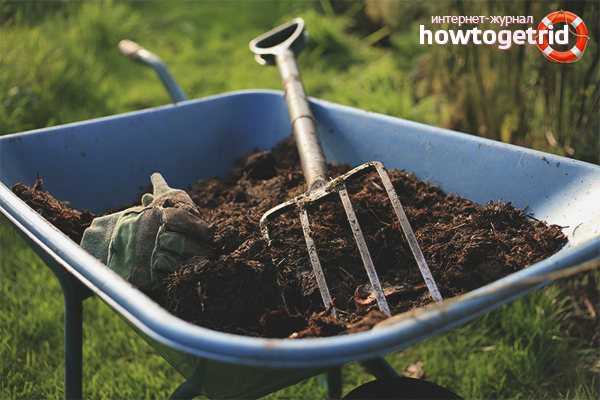

To prepare nutritious compost, you should pour it into a special pit:
- a layer of bird excrement 20–25 cm thick;
- straw - 5-10 cm;
- the same or slightly less sawdust;
- cover the workpiece with a layer of peat 10–20 cm high from above.
Place a thick film on the compost pit to speed up the maturation of the workpiece and prevent the spread of unpleasant odors throughout the area. If the heap is higher than 1 m, the temperature in the lower layers reaches + 65–70 degrees, at which the components do not die away, but "burn". Owners of large gardens should equip several heaps at once 3.5–4 m wide and 2–2.5 deep. The length of the pit is arbitrary.
how to get sow thistle out of the garden
The compost will ripen for 1.5–2 months. In addition to straw and peat, they add to the workpiece:
- weeds;
- tree bark and dry branches;
- food waste, but no chemicals like detergent or plastic bags;
- fallen leaves;
- wood shavings.
The compost is enriched with mineral and organic additives:
- superphosphate powder;
- wood ash;
- potassium salt;
- phosphate flour;
- ammonium nitrate;
- medicinal herbs like St. John's wort or chamomile.
The fertilizer will become thicker if you put a layer of turf, leafy soil, or clay. Shredded corn silk, beet tops, rotten fruits or vegetable residues are added to chicken droppings.
The bottom of the compost pit is covered with branches or dry straw, which serves as a drainage function. 1.5–2 weeks after laying the last layer, when the temperature in the pit drops to + 35–30 degrees, the components are mixed with a shovel. The procedure ensures uniform decomposition and maturation of all layers. The finished compost turns out to be dry and crumbly, it smells like damp earth or forest, if it contains wood chips.
How does chicken manure in granules affect plant growth?
If you cannot get a natural product, go to your nearest gardening store and buy fertilizer in granules. It is made by drying under vacuum at temperatures below 100 ° C. This means that it retains all the essential nutrients. The fertilizer is very light, can be stored for a long time and at the same time retains its effectiveness.
Among other things, granular fertilizer has several advantages.
- Thanks to modern cooking technology, there are no weed seeds in the fertilizer, that is, weeds will not enter the garden. In addition, pathogenic microorganisms, insect larvae and parasites that usually live in the intestines of birds are completely destroyed;
- Having applied fertilizer once on the site, its effect continues for the next three years;
- The granular fertilizer retains beneficial bacteria that improve the structure of the soil, loosening it, thereby increasing the yield of vegetables.
- Bird droppings normalize the acidity of the soil, as a result of the normalization of acidity, conditions are created that are not usual for wireworms, it gradually disappears from the soil;
- When purchasing fresh chicken manure, keep in mind that during the storage period it heats up and nitrogen leaves it rather quickly in the form of ammonia gas. Half of the nitrogen is lost during six months of storage of fresh fertilizer. This does not happen with granular. It can be stored for a long time without losing its useful properties.
- Using granular chicken fertilizer, nitrates do not accumulate in vegetables;
- Finally, unlike fresh fertilizer, granular fertilizer does not have an unpleasant odor.
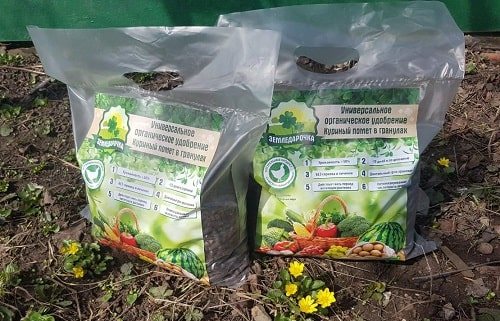

Chicken droppings from bear and other pests


Medvedka is a very vicious insect, for the extermination of which great efforts are needed. One of the folk remedies for fighting the bear is chicken droppings. The soil treated with this fertilizer has an increased concentration of nitrogen, which negatively affects the pest. Medvedka lives underground in burrows. Excess nitrogen makes it difficult for her to breathe, and therefore, she leaves this place.
Important! Cow dung has a completely different composition and, on the contrary, attracts a bear.
When fighting pests, do not forget about plants. Increased doses of nitrogen in the soil can adversely affect their growth and development. Chicken droppings will also be effective against other types of insects that live in the soil: May beetle larvae, wireworms, millipedes.
How and when to use for different crops
It is permissible to use litter in its pure form - fresh or rotted, or to prepare solutions and infusions from it. Fresh is brought under those crops for which the growth of green mass is important or under those that produce green products. It does not lay out in large quantities, it dries quickly. It is undesirable to take droppings from chickens from poultry farms, there are a lot of fresh sawdust, which, when rotted, absorb nitrogen and take it from plants.
But basically, for example, for vegetables, rotted droppings are used or liquid dressings are prepared. It contains less nitrogen, it does not accelerate the growth of green mass, but it nourishes plants perfectly.
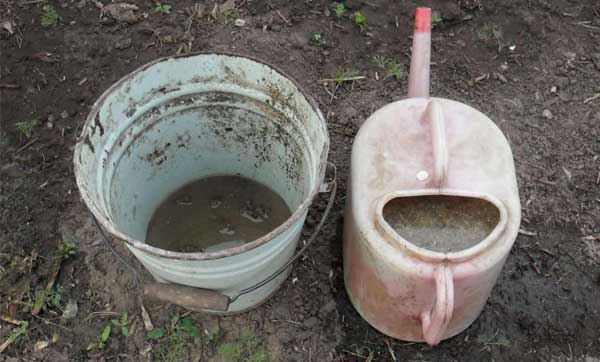

Both fresh and rotted droppings can be applied under trees and berry bushes. The easiest way is to spread dry chicken droppings evenly in the trunk circle in autumn or early spring and leave to dissolve naturally or mix with the soil while it is digging. This top dressing is done once a year. For flowers, chicken manure is better to take rotted, it must be mixed with other organic matter. Apply in a small dosage.
Recommendations for feeding with infusion of chicken droppings:
- For cucumbers - 3 times (when real leaves, flowers appear and during fruiting). Dry manure can be applied to holes of 10 g each during planting.
- Feed roses from the 2nd year of life. A solution of 1 to 20, the norm is 0.5 liters per 10 liters.During the season, it is necessary to feed the rose bushes with chicken droppings 3 times: before the onset and during flowering, the last time at the end of summer. When planting flowers, add 100-200 g of dry raw materials to the hole.
- For feeding tomatoes with chicken droppings, only 1 liter per plant is enough. Number of applications - 3 times a season. At the same time, it is necessary to dilute chicken droppings for feeding tomatoes no more than 1 to 15. When planting, add 10 g of dry raw materials to the holes. Similarly, you can feed peppers, eggplants.
- Feeding the onion with chicken droppings must be carried out before the turnip begins to form; when planting, 100 g of dry manure can be distributed over 1 sq. m. beds. The use of chicken manure for garlic is similar.
- To feed grapes with chicken droppings, you need 4-6 buckets of infusion for an adult bush. At the same time, you need to add potassium (wood ash).
- For feeding apple trees in spring and other trees, you can use an infusion of 1 bucket per plant or dry manure of 0.5 kg.
- Feed the cabbage when planting - 0.5 kg of dry raw materials per 1 sq. m. Then it is necessary to carry out another 2-3 dressing of cabbage per season, but with infusion, 1 liter at the root.
- Top dressing of carrots, beets when planting - 150 g of dry raw materials per 1 sq. m.
- For potatoes - 0.5-0.7 kg each during soil preparation.
- For strawberries - before flowering, 1 liter of solution at a concentration of 1 to 20.
It must be remembered that the droppings in contact with roots or leaves can burn them, therefore, before feeding, you need to water the plants with plain water.

